Volkswagen Taos: Safety
- General information
- Seating position
- Safety belts
- Airbag system
- Transporting children safely
- In case of an emergency
General information
Driving preparations and driving safety
Observe the following points before and during every trip, for your own
safety and for the safety of your passengers and others
on the road ⇒
 :
:
- Make sure the vehicle lighting and turn signals are functioning correctly.
- Check the tire pressure and fuel level ⇒ Checking the tire pressure, ⇒ Fuel gauge.
- Check the washer fluid level ⇒ Washer fluid.
- Ensure that the windows are clear and provide good visibility ⇒ Exterior care and cleaning.
- The air intake for the engine must not be blocked. The engine must not be covered with covers or insulation ⇒ Safety precautions for working in the engine compartment.
- Secure all objects and luggage in the storage compartments and the luggage compartment ⇒ Transporting.
- It must be possible to press the pedals without interference.
- Secure children with child restraint systems that are appropriate for their weight and height ⇒ Transporting children safely.
- Adjust the front seats, head restraints, and mirrors according to the size of the occupants ⇒ Seating position, ⇒ Mirrors.
- Wear shoes that give your feet good grip for operating the pedals.
- The floormat in the driver side footwell must be kept clear from the pedal area and be secured.
- Assume the correct seating position before driving and remain that way while driving. This also applies to all passengers ⇒ Seating position.
- Fasten the safety belt correctly before you begin driving and keep it fastened while driving. This also applies to all passengers ⇒ Safety belts.
- The number of passengers must not exceed the number of seats and safety belts.
- Never drive when impaired, for example by medication, alcohol, or drugs.
- Never allow yourself to be distracted from traffic, such as by adjusting settings, by opening menus, by passengers, or by phone calls.
- Always adapt your speed and driving style to the current visual, weather, road, and traffic conditions.
- Follow driving rules and posted speed limits.
- Take regular breaks on long trips. You should take a break at least every two hours.
- Secure animals in the vehicle restraint systems that are appropriate for their weight and size.
Driving in other countries
Some countries have special safety standards and regulations that differ from the vehicle configuration. Volkswagen recommends that you inform yourself about legal regulations and about the following points from an authorized Volkswagen dealer or authorized Volkswagen Service Facility before driving in other countries. Volkswagen recommends contacting an authorized Volkswagen dealer or authorized Volkswagen Service Facility.
- Do technical modifications need to be made to the vehicle before driving in other countries, such as covering or adjusting the headlights?
- Are the tools, diagnostic equipment, and replacement parts that are needed for maintenance and repair work available?
- Is there an authorized Volkswagen dealer or authorized Volkswagen Service Facility in the country where you will be driving?
- Are fluids that meet Volkswagen specifications available in the country where you will be driving ⇒ Operating fluids and operating equipment?
- Will the navigation function in the factory-installed Infotainment system work with the existing navigation data in the country where you will be driving?
- Are special tires needed in the country where you will be driving?
- Is a fire extinguisher required in the country where you will be driving?
- What are the requirements for a safety vest?
- Is fuel with sufficient quality available ⇒ Fuel and emissions control system ?
Checks when refueling
Only perform work on the engine and in the engine compartment if you are familiar with the necessary actions and the general safety precautions, and if the correct equipment, fluids, and suitable tools are available ⇒ Safety precautions for working in the engine compartment! Have all work performed by suitably qualified professionals. Volkswagen recommends contacting an authorized Volkswagen dealer or authorized Volkswagen Service Facility. Make sure that the following items are checked regularly:
- Washer fluid level ⇒ Washer fluid.
- Engine oil level ⇒ Engine oil.
- Engine coolant level ⇒ Engine coolant.
- Brake fluid level ⇒ Brake fluid specifications.
- Tire inflation pressure ⇒ Checking the tire pressure.
- Vehicle lighting ⇒ Exterior lighting which is necessary for traffic safety:
Information on changing bulbs ⇒ Exterior lighting.
DANGER
Read and heed the important safety instructions for the front passenger's front airbag ⇒ Safety notes on using child restraints.
WARNING
Alcohol, drugs, medication, and prescription narcotics can considerably impair perception, reaction times, and driving safety, which can result in loss of vehicle control. This can cause accidents and serious or fatal injuries.
- Do not drive under the influence of alcohol, drugs, medication or prescription narcotics.
WARNING
Not paying attention to road traffic can cause accidents and serious or fatal injuries.
- Always comply with the applicable driving regulations and speed limits and think ahead while driving.
- Take regular breaks on long drives. You should take a break at least every two hours.
NOTICE
Volkswagen is not responsible for damage to the vehicle caused by substandard fuel, insufficient maintenance, or unsuitable replacement parts.
- Only use fuel that is approved for your vehicle. The factory has placed a fuel information label on the fuel filler flap, which specifies the fuel type to be used for the vehicle.
- Volkswagen recommends the use of Volkswagen original parts or Volkswagen original accessories, which you can acquire from an authorized Volkswagen dealer or authorized Volkswagen Service Facility.
 Having the vehicle serviced
regularly not only maintains the value of the vehicle, but also contributes to
operational safety
and roadworthiness. Therefore, have maintenance procedures performed according
to Volkswagen instructions. Under
extreme operating conditions, some work may need to be performed before the next
service is due. Extreme operating
conditions can include frequent "stop-and-go" driving or driving in areas with a
lot of dust in the air. For further information,
contact an authorized Volkswagen dealer or authorized Volkswagen Service
Facility. Volkswagen recommends contacting
an authorized Volkswagen dealer or authorized Volkswagen Service Facility.
Having the vehicle serviced
regularly not only maintains the value of the vehicle, but also contributes to
operational safety
and roadworthiness. Therefore, have maintenance procedures performed according
to Volkswagen instructions. Under
extreme operating conditions, some work may need to be performed before the next
service is due. Extreme operating
conditions can include frequent "stop-and-go" driving or driving in areas with a
lot of dust in the air. For further information,
contact an authorized Volkswagen dealer or authorized Volkswagen Service
Facility. Volkswagen recommends contacting
an authorized Volkswagen dealer or authorized Volkswagen Service Facility.
Seating position
Introduction
Number of seats
The vehicle has a total of five seats: two seats in the front and three seats in the back.
Every seat is equipped with a safety belt.
WARNING
Sitting incorrectly in the vehicle can increase the risk of serious or fatal injuries during sudden driving or braking maneuvers, in the event of a collision or accident, and if the airbags are deployed.
- Before the vehicle starts to move, all vehicle occupants must always be in the correct seating position and maintain it while driving. Safety belts must also be fastened and remain fastened.
- The number of persons in the vehicle must not exceed the number of seats with safety belts.
- Always secure children in the vehicle with an approved and suitable child restraint system according to the child's body size and weight ⇒ Transporting children safely and ⇒ Airbag system.
- Always keep feet in the footwell while driving. For example, never rest feet on the seat or on the instrument panel and never hold feet out of the window. Otherwise, if the airbag and the safety belt deploy, they could increase the risk of injury in the event of an accident instead of providing protection.
Risk of injury due to an incorrect seating position
Please read the introductory information and heed the Warnings and
Notice ⇒
 Introduction.
Introduction.
The risk of serious or fatal injuries will increase if safety belts are not worn or are incorrectly fastened. Safety belts can only achieve the optimum protection if they are routed correctly. An incorrect seating position significantly impairs the protective function of the safety belt. This could result in serious or fatal injuries. The risk of serious or fatal injuries increases even more if a deployed airbag strikes a passenger who is sitting in an incorrect seating position. The driver is responsible for all vehicle occupants and especially for children who are being transported in the vehicle.
The following list includes examples of seating positions that could be dangerous for all vehicle occupants.
The following points always apply when the vehicle is in motion:
- Never stand inside the vehicle.
- Never stand on the seats.
- Never kneel on the seats.
- Never tilt your seat backrest too far back.
- Never lean against the instrument panel.
- Never lay down in the seats in the vehicle interior or on the rear bench seat.
- Never sit only on the front section of the seat.
- Never sit sideways on the seat.
- Never lean against the window.
- Never place your feet out of the window.
- Never place your feet on the instrument panel.
- Never place your feet on the seat cushion or on the seat backrest.
- Never ride in the footwell.
- Never sit on the armrests.
- Never drive or ride in a seat without fastening your safety belt.
- Never ride in the trunk.
WARNING
Incorrect seating positions in the vehicle increase the risk of serious or fatal injuries in the event of an accident or sudden driving and braking maneuvers, especially if the airbags are deployed and exert force on a vehicle occupant who is not sitting correctly.
- All vehicle occupants must always sit in the correct seating position and have their own safety belts correctly fastened while driving.
Correct seating position
Please read the introductory information and heed the Warnings and
Notice ⇒
 Introduction.
Introduction.
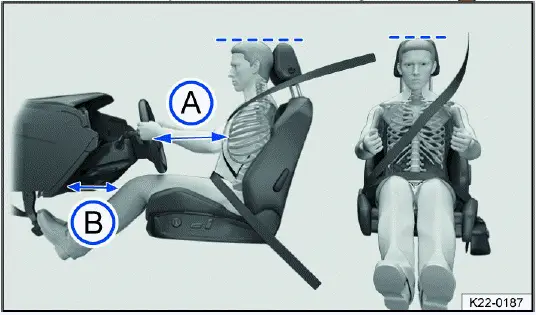
Fig. 21 Correct distance between the driver and the steering wheel, correct
safety belt position and correct head restraint adjustment (general example).
The correct seating positions for the driver and passengers are specified in the information that follows. The safety belt and airbags only provide the optimum protection when vehicle occupants are seated in a correct seating position.
If you have a physical impairment that prevents you from sitting correctly on the driver seat with a correctly worn safety belt and reaching the pedals, special modifications to your vehicle may be necessary. For information on possible changes to your vehicle, contact an authorized Volkswagen dealer or authorized Volkswagen Service Facility qualified for this. Volkswagen recommends contacting an authorized Volkswagen dealer or authorized Volkswagen Service Facility. Alternatively, contact the Volkswagen Customer CARE Center at +00 (1) 800 822 8987.
For your safety and to reduce the risk of injuries in the event of a sudden braking maneuver or accident, Volkswagen recommends the following seating positions:
The following applies to all vehicle occupants:
- Adjust the head restraint so that the upper edge of the head restraint is in line with the upper portion of the head as much as possible, but not lower than eye level. Position the back of the head as close as possible to the head restraint fig. 21.
- For shorter individuals, slide the head restraint all the way downward, even if the head is then below the upper edge of the head restraint.
- For taller individuals, move the head restraint upward all the way.
- Keep both feet in the footwell while driving.
- Adjust and fasten the safety belts correctly ⇒ Safety belts.
The following additional points apply to the driver:
- Adjust the forward/back position of the driver seat so that you can press the pedals while your legs are slightly bent and there is at least 10 cm (around 4 inches) of space between the instrument panel and your knees fig. 21.
- Adjust the driver seat so that the top point of the steering wheel can be reached.
- Position the seat backrest in an upright position, so that your back rests completely on the seat backrest.
- Adjust the steering wheel so that the distance between the steering wheel and your chest is at least 25 cm (around 10 inches) fig. 21 and you can hold the steering wheel firmly at the sides with both hands and your elbows slightly bent.
- When adjusted, the steering wheel must always face your chest and not be directed toward your face.
- In vehicles with head restraints that can be moved forward or back, position the head restraint so that it is as close as possible to the back of the head.
- Always keep both feet in the footwell to keep control of the vehicle at all times.
The following additional points apply to the front passenger:
- In vehicles with head restraints that can be moved forward or back, position the head restraint so that it is as close as possible to the back of the head.
- Position the seat backrest in an upright position, so that your back rests completely on the seat backrest.
- Push the front passenger seat back into the rear half of the adjustable range so that the airbag can provide optimum protection if it deploys.
Safety belts
Introduction
Check the condition of all of the safety belts regularly. If there is damage
to the belt fabric, the belt connections, the automatic
safety belt retractor or the buckle, have the affected safety belt replaced
immediately by suitably qualified professionals ⇒
 . The authorized Volkswagen dealer or
authorized Volkswagen Service Facility must use the correct parts for the
vehicle, equipment and model year. Volkswagen recommends contacting an
authorized Volkswagen dealer or authorized Volkswagen
Service Facility.
. The authorized Volkswagen dealer or
authorized Volkswagen Service Facility must use the correct parts for the
vehicle, equipment and model year. Volkswagen recommends contacting an
authorized Volkswagen dealer or authorized Volkswagen
Service Facility.
WARNING
The risk of serious and fatal injuries increases if the safety belts are not worn or are worn incorrectly.
- Safety belts are the most effective way to reduce the risk of serious and fatal injuries in a collision. Before every trip, vehicle occupants must therefore seat themselves correctly, fasten the safety belt that belongs to the seat they are using, and keep it fastened while the vehicle is in motion. This applies to all passengers and at all times, including during city driving.
- Secure only one person with a safety belt.
- Secure children in the vehicle with a child restraint that is appropriate for their weight and height and with the safety belt used correctly ⇒ Transporting children safely.
- Never allow children or infants to ride on anyone's lap and never strap children or infants to another person with the same safety belt.
- Only ever insert and latch the buckle tongue in the belt buckle for the corresponding seat. Using a buckle from another seat reduces the protection provided by the safety belt and can cause serious injuries.
- Do not wear extremely bulky, loose clothing in the vehicle, such as a coat over a sports jacket, because this could impair the fit and function of the safety belt.
WARNING
If the belt webbing or other parts of the safety belts are damaged, the safety belts could tear during a collision or sudden braking maneuver and cause serious or fatal injuries.
- Never damage the safety belts by trapping them or chafing them on sharp edges.
- Have damaged safety belts replaced immediately with new safety belts that are approved for the vehicle by Volkswagen. Safety belts that are stretched during a collision must be replaced by an authorized Volkswagen dealer or authorized Volkswagen Service Facility. Volkswagen recommends contacting an authorized Volkswagen dealer or authorized Volkswagen Service Facility. It may be necessary to replace them even if there is no visible damage. Check the safety belts' anchorage points as well.
- Never try to repair, modify, or remove the safety belts yourself. Have all repairs on safety belts, automatic safety belt retractors and buckle parts performed only by an authorized Volkswagen dealer or authorized Volkswagen Service Facility. Volkswagen recommends contacting an authorized Volkswagen dealer or authorized Volkswagen Service Facility.
Fasten seat belts reminder and seat belt safety indicator
Please read the introductory information and heed the Warnings and
Notice ⇒
 Introduction.
Introduction.
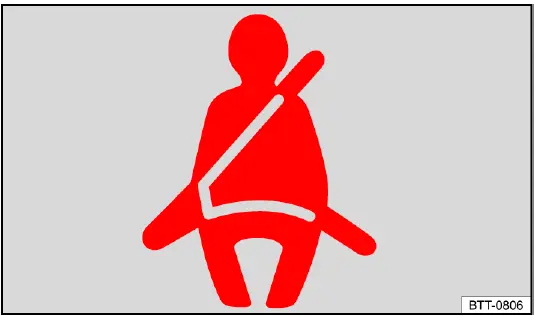
Fig. 22 In the instrument cluster display: warning light for the fasten seat
belts reminder.
 The driver or front passenger
has not fastened their safety belt. Fasten all safety belts.
The driver or front passenger
has not fastened their safety belt. Fasten all safety belts.
When the ignition is switched on, several warning and indicator lamps light up temporarily as a function check. They then turn off after a few seconds.
A chime also sounds.
When the ignition is switched on, the red
 warning light comes on for six
seconds. A chime also sounds for up to six seconds
if the driver safety belt is not fastened. The chime ends when the driver
fastens their safety belt. The warning lamps and chime
go off when the driver and front passenger have fastened their safety belts.
warning light comes on for six
seconds. A chime also sounds for up to six seconds
if the driver safety belt is not fastened. The chime ends when the driver
fastens their safety belt. The warning lamps and chime
go off when the driver and front passenger have fastened their safety belts.
If the driver and front passenger do not both fasten their safety belts within
10 seconds after the warning chime has ended and
the vehicle is driving at a speed above approx. 25 km/h (approx. 15 mph), the
chime sounds again for approx. 6 seconds, then
stops for approx. 24 seconds, and then sounds again for approx. 6 seconds. The
same happens if one of the safety belts is
released while driving. The red
 warning light comes on. A warning chime also sounds for up to two minutes at
24-second
intervals. The chime does not sound at speeds below approx. 8 km/h (approx. 5
mph).
warning light comes on. A warning chime also sounds for up to two minutes at
24-second
intervals. The chime does not sound at speeds below approx. 8 km/h (approx. 5
mph).
When the ignition is switched on, the red
 warning light comes on until the
driver and front passenger have both fastened
their safety belts.
warning light comes on until the
driver and front passenger have both fastened
their safety belts.
WARNING
The risk of serious and fatal injuries increases if the safety belts are not worn or are worn incorrectly.
- Fasten the safety belts and use them correctly to ensure that they provide optimum protection.
Using safety belts
Please read the introductory information and heed the Warnings and
Notice ⇒
 Introduction.
Introduction.
Checklist
Using safety belts ⇒
 :
:
- Check the condition of all of the safety belts regularly.
- Keep safety belts clean.
- Always keep foreign objects and fluids far away from the safety belt, the safety belt buckle, and the slot in the safety belt buckle.
- Do not pinch or damage the safety belt and/or belt buckle, for example closing it in a door.
- Never remove, modify, or repair the safety belt and belt fastening elements.
- Always fasten the safety belt correctly before you begin driving and keep it fastened while driving.
Twisted safety belt
If the safety belt is difficult to pull out of the belt guide, the safety belt may have been pulled out too quickly when positioning the belt and may have become twisted within the side trim panel:
1. Slowly and carefully pull the safety belt out completely by the belt buckle.
2. Untwist the safety belt and guide the safety belt back slowly by hand.
If you cannot untwist the safety belt, fasten the safety belt anyway. The twist must not be in a belt area that lies directly against the body. Contact an authorized Volkswagen dealer or authorized Volkswagen Service Facility immediately to have the twist rectified. Volkswagen recommends contacting an authorized Volkswagen dealer or authorized Volkswagen Service Facility.
Lockable safety belt
The safety belts on the rear seats and the safety belt on the front passenger seat are lockable and have an emergency locking function. With the locking function, you can adjust the safety belt so that a child restraint is properly installed ⇒ Securing a child restraint with a safety belt.
Safety belts may only be locked for certain child restraint systems ⇒ Child restraints - overview.
An activated locking mechanism must be released when a vehicle occupant fastens their safety belt. To release the lock, push the red button in the belt buckle and guide the seat belt back fully by hand.
WARNING
Incorrect handling of the safety belts increases the risk of severe or fatal injuries.
- Check the safety belts and associated components regularly to ensure they function correctly.
- Never attempt to repair safety belts. Have damaged safety belts replaced.
- Always keep the safety belts clean.
- Never damage the safety belts by trapping them or chafing them on sharp edges.
- Always keep the belt buckle and insertion guide for the belt buckle free of foreign objects and fluids.
Fastening and unfastening the safety belts
Please read the introductory information and heed the Warnings and
Notice ⇒
 Introduction.
Introduction.
Safety belts that are fastened correctly hold vehicle occupants in the
correct position during braking maneuvers or in a
collision, in order to provide the maximum protection ⇒
 .
.
Fastening the safety belt
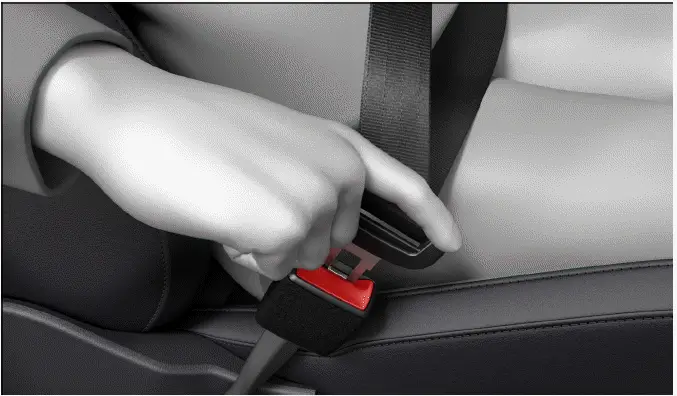
Fig. 23 Inserting the buckle tongue into the safety belt buckle (general
example).
Always fasten the safety belts before driving.
1. Adjust the front seat and head restraint correctly ⇒ Seating position.
2. Have the rear seat backrest locked into place in an upright position ⇒
 .
.
3. Grab the belt and pull it evenly over the chest and pelvis. Do not twist the
belt while doing this ⇒
 .
.
4. Insert the buckle tongue securely in the safety belt buckle for that seat fig. 23.
5. Pull on the safety belt to make sure the buckle tongue is latched correctly in the safety belt buckle.
Unfastening the safety belt
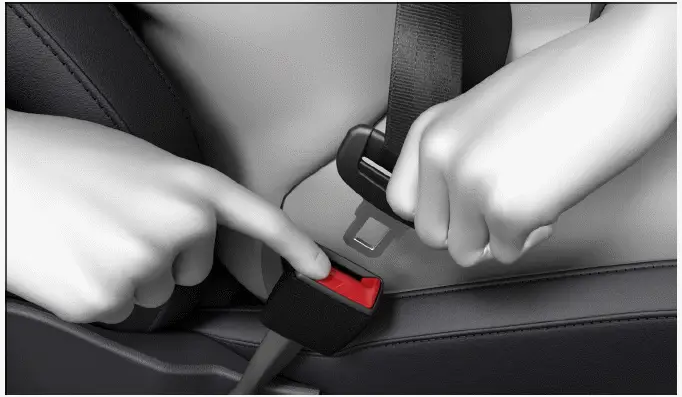
Fig. 24 Releasing the buckle tongue from the safety belt buckle (general
example).
Only unfasten the safety belt while the vehicle is stationary ⇒
 .
.
1. Press the red button in the safety belt buckle fig. 24.
The buckle tongue will pop out.
2. Guide the belt back by hand so that the belt rolls up easily, the belt does not twist, and the trim panel is not damaged.
WARNING
Incorrect safety belt positioning or unfastening the safety belt while the vehicle is in motion can lead to serious or fatal injuries in the event of an accident or braking maneuver.
- Place the backrest in an upright position and position your safety belt correctly for your size to maximize the protective function of the safety belt.
- Never unfasten the safety belt while the vehicle is in motion.
Safety belt positioning
Please read the introductory information and heed the Warnings and
Notice ⇒
 Introduction.
Introduction.
Safety belts only offer the optimum protection during a collision and reduce the risk of serious injury or death if they are fastened and positioned correctly. The correct safety belt position also holds the vehicle occupant in place so that the airbags can provide their maximum protection if they deploy. Therefore, all vehicle occupants should always fasten their own safety belts and make sure they are positioned correctly fig. 25.
An incorrect seating position can cause severe or fatal injuries ⇒ Seating position.
Correct safety belt positioning
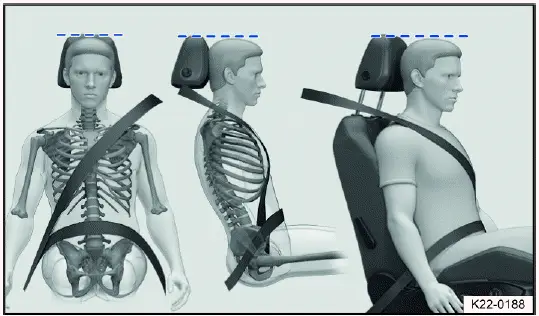
Fig. 25 Correct safety belt positioning and correct head restraint adjustment
(general example).
- The shoulder belt section of the safety belt must always be positioned over the center of the shoulder and never across the neck, above the arm, under the arm, or behind the back.
- The lap section of the safety belt must always lie across the lap and never over the stomach.
- The safety belt must always rest flat and securely on the body. Retighten the belt if necessary.
Correct safety belt positioning for pregnant women
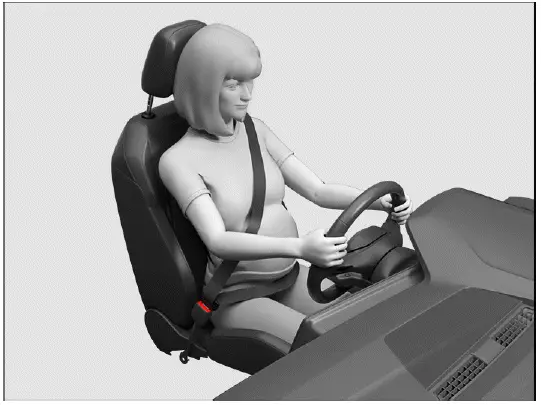
Fig. 26 Correct safety belt positioning for pregnant women (general example).
For pregnant women, the safety belt must rest evenly across the chest and as low and flat as possible on the lap, so that no pressure is applied to the lower abdomen. This should be done throughout the entire pregnancy fig. 26.
Adjusting the safety belt position to body size
The belt positioning can be adjusted with the following equipment:
- Belt height adjusters for the front seats ⇒ Safety belt height adjuster.
- Height-adjustable front seats ⇒ Seating position.
WARNING
Incorrect safety belt positioning can cause serious injuries in the event of an accident or during sudden braking or driving maneuvers.
- Ensure your safety belt is positioned correctly.
- Place the backrest in an upright position and position your safety belt correctly for your size to maximize the protective function of the safety belt.
- Place the shoulder portion of the safety belt over the center of your shoulder, and never under your arm or across your neck.
- Lay the safety belt flat and securely on the upper part of the body and pelvis. Retighten the belt if necessary.
- Ensure the lap section of the safety belt lies across your lap and never over your stomach.
- Throughout your pregnancy, ensure the safety belt rests evenly across your chest and as low and flat as possible on your lap. This will prevent pressure being applied to your lower abdomen.
- Do not twist the safety belt while wearing it.
- Never hold the safety belt away from the body with your hand.
- Do not guide the safety belt over hard or breakable objects, such as eyeglasses, pens, or keys.
- Do not modify how the safety belt is routed using belt clips, retaining loops, or similar objects.
 Persons who cannot achieve
the optimum belt routing due to physical conditions should contact an authorized
Volkswagen dealer or authorized Volkswagen Service Facility about possible
special modifications that can be used to
achieve the best possible protection with the safety belt and airbags.
Volkswagen recommends contacting an authorized
Volkswagen dealer or authorized Volkswagen Service Facility.
Persons who cannot achieve
the optimum belt routing due to physical conditions should contact an authorized
Volkswagen dealer or authorized Volkswagen Service Facility about possible
special modifications that can be used to
achieve the best possible protection with the safety belt and airbags.
Volkswagen recommends contacting an authorized
Volkswagen dealer or authorized Volkswagen Service Facility.
Safety belt height adjuster
Please read the introductory information and heed the Warnings and
Notice ⇒
 Introduction.
Introduction.
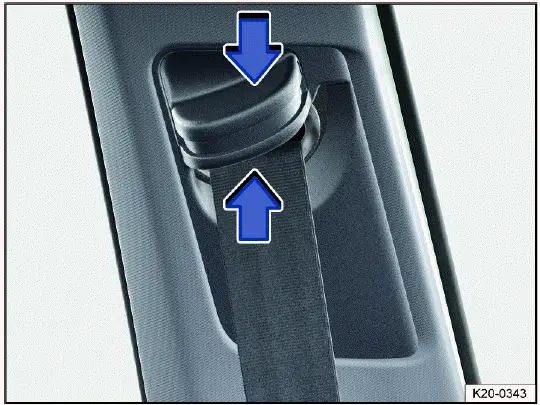
Fig. 27 Next to the front seats: safety belt height adjuster.
You can use the safety belt height adjuster to adjust the safety belt routing in the shoulder area according to your individual body size, so that the safety belt can be correctly fastened:
1. Push down and hold the safety belt height adjustment button in the direction of the arrows fig. 27.
2. Slide the safety belt height adjuster upward or downward until the safety belt lies over the center of the shoulder ⇒ Safety belt positioning.
3. Release the safety belt height adjustment button.
4. Pull hard on the safety belt to check that the safety belt height adjuster is engaged.
WARNING
Changing the safety belt height while driving may cause serious or fatal injuries.
- Never adjust the safety belt height while driving.
Automatic safety belt retractor, safety belt pretensioner, safety belt load limiter
Please read the introductory information and heed the Warnings and
Notice ⇒
 Introduction.
Introduction.
The vehicle seat belts are part of the vehicle safety concept⇒ Airbag system. The vehicle safety concept has the following key functions:
Automatic safety belt retractor
Every safety belt is equipped with an automatic safety belt retractor on the shoulder belt section. If the safety belt is pulled slowly or while driving normally, the shoulder belt will be able to move freely. The automatic safety belt retractor blocks the safety belt from moving if the safety belt is pulled out quickly, for example during sudden braking maneuvers, when driving on hills, when driving around curves and when accelerating.
Safety belt pretensioners
The safety belts for the driver and front seat passenger are equipped with safety belt pretensioners.
Safety belt pretensioners are activated by sensors and tighten the safety belts in the event of severe front-on, side and rear collisions or if the vehicle rolls over. If the safety belt is loose, it retracts. This can reduce the forward movement of the vehicle occupants and movement of the vehicle occupants in the direction of the collision. The safety belt pretensioner works together with the airbag system. The safety belt pretensioner is only activated during a rollover accident if the Side Curtain Protection airbags are deployed.
Fine dust may appear if airbags deploy. This is completely normal and does not indicate a fire in the vehicle.
WARNING
The safety belt pretensioners only provide protection for one deployment. If the safety belt pretensioners deploy, the system must be replaced.
- Have deployed safety belt pretensioners and affected system components replaced immediately with new parts that are approved by Volkswagen for the vehicle.
- Only have suitably qualified professionals make repairs or modifications to a vehicle. Authorized Volkswagen dealers and authorized Volkswagen Service Facilities have the required tools, diagnostic devices, repair information, and qualified personnel. Volkswagen recommends contacting an authorized Volkswagen dealer or authorized Volkswagen Service Facility.
- Never install safety belt pretensioner components removed from scrap vehicles or from recycling.
- Never modify any components of the safety belt pretensioners.
Safety belt load limiter
Safety belt load limiters reduce the force placed on the body by the safety belts during a collision.
 When disposing of the vehicle
or of individual system components, all safety precautions must be observed. An
authorized
Volkswagen dealer or authorized Volkswagen Service Facility will be familiar
with these provisions ⇒ Safety belt
pretensioner servicing and disposal. Volkswagen recommends contacting an
authorized Volkswagen dealer or authorized
Volkswagen Service Facility.
When disposing of the vehicle
or of individual system components, all safety precautions must be observed. An
authorized
Volkswagen dealer or authorized Volkswagen Service Facility will be familiar
with these provisions ⇒ Safety belt
pretensioner servicing and disposal. Volkswagen recommends contacting an
authorized Volkswagen dealer or authorized
Volkswagen Service Facility.
Safety belt pretensioner servicing and disposal
Please read the introductory information and heed the Warnings and
Notice ⇒
 Introduction.
Introduction.
When working on safety belt pretensioners, as well as when removing and installing other vehicle components as part of repair work, the safety belts can become damaged without you noticing. This may cause the safety belt pretensioner to not work correctly or prevent it from working in the event of an accident.
The instructions must be followed so that the effectiveness of the safety belt pretensioner is not impaired and removed components do not cause injuries and environmental pollution. An authorized Volkswagen dealer or authorized Volkswagen Service Facility will be familiar with these provisions. Volkswagen recommends contacting an authorized Volkswagen dealer or authorized Volkswagen Service Facility.
WARNING
Repairs that you perform yourself or that are performed incorrectly on the safety belts, automatic safety belt retractors, and safety belt pretensioners can increase the risk of severe or fatal injuries. The safety belt pretensioner may not deploy when it should, or it may deploy unexpectedly.
- Never perform repairs, adjustments, or removal and installation of components of the safety belt pretensioners or safety belts yourself. Only have these procedures performed by suitably qualified professionals ⇒ Accessories, replacement parts, repairs, and modifications. Volkswagen recommends contacting an authorized Volkswagen dealer or authorized Volkswagen Service Facility.
- Safety belts, safety belt pretensioners and automatic safety belt retractors cannot be repaired. These components must be replaced.
 Some parts of the vehicle, such
as the airbag module and safety belt pretensioners, may contain perchlorate.
Special
handling may be required. For further information, visit https://dtsc.ca.gov/perchlorate.
Some parts of the vehicle, such
as the airbag module and safety belt pretensioners, may contain perchlorate.
Special
handling may be required. For further information, visit https://dtsc.ca.gov/perchlorate.
Airbag system
Introduction
The vehicle is equipped with a front airbag for the driver and one for the front passenger. The front airbags can offer additional protection for the chest and head of the driver and front passenger as long as the seat, the safety belt, the head restraint, and the steering wheel are adjusted and used correctly. Airbags are only designed to offer supplementary protection. Airbags are not a replacement for safety belts. Safety belts must always be worn, even if the front seats are fitted with front airbags.
WARNING
Relying solely on the airbag system to protect yourself may result in serious injury or death. The airbags only provide a supporting safety function. The airbag system provides optimum protection when the safety belt is worn correctly and the correct seating position is used.
- Before every trip, everyone in the vehicle must seat themselves correctly, fasten the safety belt that belongs to the seat they are using, and keep it fastened while the vehicle is in motion. This applies to all passengers and at all times, including during city driving.
- Never rely solely on the airbag system.
WARNING
An incorrect seating position may prevent the front airbag from providing proper protection and cause serious injuries.
- Always hold the steering wheel with both hands on the sides of the outer edge, in the nine o'clock and three o'clock position.
- Adjust the driver seat so that there is a distance of at least 25 cm (10 inches) between your chest and the center of the steering wheel. If body characteristics mean that this is not possible, you must contact an authorized Volkswagen dealer or authorized Volkswagen Service Facility. Volkswagen recommends contacting an authorized Volkswagen dealer or authorized Volkswagen Service Facility.
- Adjust the front passenger seat so that there is the greatest possible distance between the front passenger and the instrument panel.
WARNING
Incorrect seating positions in the vehicle increase the risk of serious or fatal injuries in the event of an accident or sudden driving and braking maneuvers, especially if the airbags are deployed and exert force on a vehicle occupant who is not sitting correctly.
- All vehicle occupants must always sit in the correct seating position and have their own safety belts correctly fastened while driving.
WARNING
The risk of serious and fatal injuries may increase if the safety belts are not worn or are worn incorrectly.
- Before every trip, everyone in the vehicle must seat themselves correctly, fasten the safety belt that belongs to the seat they are using, and keep it fastened while the vehicle is in motion.
- Secure children before and during every journey in the vehicle with a child restraint system that is appropriate for their weight and height and with the safety belt used correctly ⇒ Transporting children safely.
- Always insert the buckle tongue into the belt buckle that belongs to that seat and let it engage securely. Using a buckle from another seat reduces the protection provided by the safety belt and can cause serious injuries.
- Never unfasten the safety belt while the vehicle is in motion.
- Secure only one person with a safety belt.
- Never allow children or infants to ride on anyone's lap and never strap children or infants to another person with the same safety belt.
- Do not wear extremely bulky, loose clothing in the vehicle, such as a coat over a sports jacket, because this could impair the fit and function of the safety belt.
WARNING
An incorrect seating position reduces the effectiveness of the airbags and increases the risk of injury in the event of a collision.
- Always fasten your safety belt correctly to reduce the risk of injury if an airbag deploys.
- Adjust the front seats correctly.
- Position the seat backrest in an upright position, so that your back rests completely on the seat backrest.
WARNING
The risk of injury if the airbag deploys increases if there are objects located between vehicle occupants and the airbag deployment zone. These objects could change the deployment zone of the airbag or could strike the vehicle occupants.
- Never hold objects in your hands or on your lap while driving.
- Never transport objects on the front passenger's seat. During sudden braking or driving maneuvers, the objects could move into the airbag deployment zone and then be thrown through the vehicle interior if the airbag deploys.
- There should be no people, animals, or objects between the vehicle
occupants and the airbag deployment zone.
Make sure that children and other passengers also follow this instruction.
WARNING
Once the airbags have been deployed, they lose their protective function and must be replaced. If the airbags do not have their protective function, the risk of injury during sudden braking or driving maneuvers or accidents increases.
- Have any deployed safety airbags and affected system components replaced immediately with new parts that are approved by Volkswagen for the vehicle.
- Only have suitably qualified professionals make repairs or modifications to a vehicle. Authorized Volkswagen dealers and authorized Volkswagen Service Facilities have the required tools, diagnostic devices, repair information, and qualified personnel. Volkswagen recommends contacting an authorized Volkswagen dealer or authorized Volkswagen Service Facility.
- Never install airbag components removed from scrap vehicles or from recycling.
- Never modify components of the airbag system.
WARNING
Fine dust and water vapor can develop when the airbags deploy. This is normal and does not indicate a fire in the vehicle.
The fine dust can irritate the skin and mucous membranes in the eyes and can cause breathing problems, particularly for individuals who have asthma or other respiratory conditions.
- To reduce the risk of breathing problems, exit the vehicle or open the windows or doors for fresh air.
- If you come into contact with the dust, wash your hands and face with mild soap and water before eating anything.
- Flush your eyes and any open wounds with water if dust enters them.
WARNING
Cleaners that contain solvents can make the surface around the airbag installation locations porous. Plastic pieces that come loose could be thrown through the vehicle interior and cause serious injuries in the event of a collision with airbag deployment.
- Never treat the instrument panel and the surfaces around the airbag installation locations with cleaners that contain solvents.
Advanced Airbag System
Please read the introductory information and heed the Warnings and
Notice ⇒
 Introduction.
Introduction.
Read and follow the introductory information and safety precautions ⇒ Safety notes on using child restraints.
An active passenger's front airbag presents serious dangers for a child ⇒
 . For
this reason, all children under the age of
twelve must be secured in the rear seats while the vehicle is in motion.
. For
this reason, all children under the age of
twelve must be secured in the rear seats while the vehicle is in motion.
The Advanced Airbag System, together with the side and Side Curtain Protection
airbags, is checked every time the ignition
is switched on. The yellow airbag indicator light
 comes on briefly and turns off after
several seconds.
comes on briefly and turns off after
several seconds.
Features of the Advanced Airbag System:
- Front passenger's front airbag in the instrument panel
- Yellow indicator light
 in
the instrument cluster display.
in
the instrument cluster display. - Yellow PASSENGER AIR BAG indicator light
 .
. - Yellow PASSENGER AIR BAG indicator light
 .
.
If the status of the
 indicator light is one of the following, the Advanced Airbag System must be
checked by an
authorized Volkswagen dealer or authorized Volkswagen Service Facility:
indicator light is one of the following, the Advanced Airbag System must be
checked by an
authorized Volkswagen dealer or authorized Volkswagen Service Facility:
- The indicator light does not come on for several seconds when the ignition is switched on.
- The indicator light stays on after the ignition is switched on.
- The indicator light comes on or flashes again after it is turned off.
- The indicator light comes on while driving.
Advanced Airbag System, small children, child restraints and children on the front passenger seat
The Advanced Airbag System in your vehicle has been certified and complies with the regulations of the United States Federal Motor Vehicle Safety Standard (FMVSS) 208 and the Canada Motor Vehicle Safety Standard (CMVSS) 208 at the time of vehicle manufacture. In accordance with the requirements, the system on the passenger's side has been designed to "inhibit" deployment for small children of up to 12 months of age and "low-risk deployment" for children of between three and six years of age.
The airbag on the passenger's side is a potential danger for children when it is deployed. The front passenger seat is not the safest place for a child in a forward-facing child restraint and a very dangerous place for an infant or a child in a rear-facing child restraint.
The Advanced Airbag System has a capacitive detection system in the seat cushion of the front passenger seat which detects whether a baby, small child or child is in a child restraint on the front passenger seat.
The capacitive detection system measures the electrical capacity of a child, the child restraint and a child's blanket on the front passenger seat.
The electrical capacity of a child restraint depends on the child restraint type. Together with the average capacity values of small children and one-year-old children, the capacity values of all child restraints specified in accordance with FMVSS 213 and CMVSS 213 are stored in the Advanced Airbag System control module. These are compared with the values detected.
Only use child restraints that are specified according to these standards and have been approved by the child restraint manufacturer for use with airbag systems. The U.S. National Highway Traffic Safety Administration (NHTSA) has published a list of certified child restraint models for use with the Advanced Airbag System in accordance with FMVSS 208.
Only install child restraints on the front passenger seat under exceptional
circumstances. Carefully read all of the information
about child restraints and the Advanced Airbag System beforehand and follow all
instructions and warnings. Make sure that
the system has correctly detected the child restraint on the front passenger
seat and the front passenger's front air bag has
been switched off. The yellow
 PASSENGER AIR BAG indicator light will come on.
PASSENGER AIR BAG indicator light will come on.
DANGER
The front passenger seat of a vehicle is a potential danger to children (even for advanced airbags). In the event that the front passenger seat air bag is deployed, children who are completely unsecured in an unsecured child restraint or in a rear-facing child restraint on the front passenger seat will suffer serious or fatal injuries.
- Even if your vehicle is equipped with an Advanced Airbag System, make sure that children (particularly children younger than 12 years of age) are always transported in such a way that they are secured to the rear seats according to their age and size.
Indicator light for front passenger's front airbag
Please read the introductory information and heed the Warnings and
Notice ⇒
 Introduction.
Introduction.
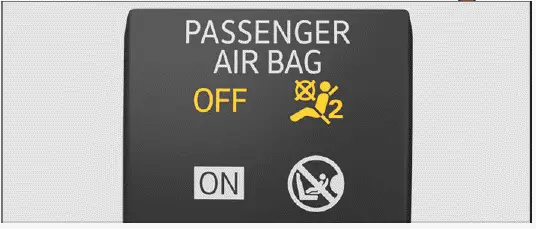
Fig. 28 In the center console: indicator light for the switched off front
passenger's front airbag.
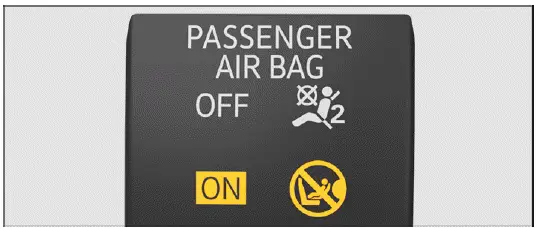
Fig. 29 In the center console: indicator light for the activated passenger's
front airbag.
The yellow PASSENGER AIR BAG indicator light
 fig. 28 comes on as soon as the
Advanced Airbag System has
deactivated the front passenger airbag.
fig. 28 comes on as soon as the
Advanced Airbag System has
deactivated the front passenger airbag.
The yellow PASSENGER AIR BAG indicator light
 fig. 29 comes on as soon as the
Advanced Airbag System has
activated the front passenger airbag.
fig. 29 comes on as soon as the
Advanced Airbag System has
activated the front passenger airbag.
If the yellow PASSENGER AIR BAG indicator light
 malfunctions, the yellow indicator
light
malfunctions, the yellow indicator
light
 appears in the
instrument cluster to indicate a malfunction. A faulty indicator light does not
affect the function of the front passenger's front
airbag, but the yellow PASSENGER AIR BAG indicator light
appears in the
instrument cluster to indicate a malfunction. A faulty indicator light does not
affect the function of the front passenger's front
airbag, but the yellow PASSENGER AIR BAG indicator light
 can no longer be used to display
the status of the front
passenger's front airbag. Get professional assistance immediately to have the
system checked. Volkswagen recommends
contacting an authorized Volkswagen dealer or authorized Volkswagen Service
Facility.
can no longer be used to display
the status of the front
passenger's front airbag. Get professional assistance immediately to have the
system checked. Volkswagen recommends
contacting an authorized Volkswagen dealer or authorized Volkswagen Service
Facility.
The yellow
 PASSENGER AIR BAG
indicator light blinks for around five seconds in the following situations:
PASSENGER AIR BAG
indicator light blinks for around five seconds in the following situations:
- The capacitive passenger detection system detects that the front passenger seat is not occupied.
- The capacitive passenger detection system detects a child restraint according to FMVSS 208 or CMVSS 208 ⇒ Airbag system.
The yellow
 PASSENGER AIR BAG
indicator light blinks for around five seconds when the capacitive passenger
detection system has detected an adult occupying the seat. The yellow PASSENGER
AIR BAG indicator light
PASSENGER AIR BAG
indicator light blinks for around five seconds when the capacitive passenger
detection system has detected an adult occupying the seat. The yellow PASSENGER
AIR BAG indicator light
 then
lights up for about 60 seconds and goes out.
then
lights up for about 60 seconds and goes out.
Ensure that the status of the airbag (on or off) is shown correctly by the indicator light according to the load on the seat.
The yellow PASSENGER AIR BAG indicator light
 must come on when the ignition is
switched on and an infant carrier
or child restraint is installed on the front passenger seat and the measured
capacity is less than or equal to the capacity of an
average one-year old child in a child restraint system as per FMVSS 208 or CMVSS
208.
must come on when the ignition is
switched on and an infant carrier
or child restraint is installed on the front passenger seat and the measured
capacity is less than or equal to the capacity of an
average one-year old child in a child restraint system as per FMVSS 208 or CMVSS
208.
If the front passenger seat is not occupied, the front passenger's front airbag is also deactivated and the indicator light remains on.
Never install a rear-facing child restraint on the front passenger seat. The safest place for a child restraint is on the rear seat.
Under these conditions, the yellow PASSENGER AIR BAG indicator light
 must come on permanently whenever
the
ignition is on. If this is not the case, stop the vehicle as soon as it is safe
to do so and follow these instructions:
must come on permanently whenever
the
ignition is on. If this is not the case, stop the vehicle as soon as it is safe
to do so and follow these instructions:
- Switch the ignition off for at least 4 seconds and then on again.
- Remove the child restraint from the front passenger seat and install it
again according to the manufacturer's instructions.
When doing so, ensure that the child restraint is installed correctly.
- Ensure that the safety belt has been guided around the child restraint correctly and that it is secure.
- Ensure that there are no electronic devices on the front passenger seat.
- Ensure that the safety belt and belt buckle are working correctly and not blocked.
- Ensure that no seat heating or similar systems have been retrofitted.
- Ensure that there are no damp objects on the front passenger seat.
If the yellow PASSENGER AIR BAG indicator light
 still does not come on, remove the
child restraint immediately and
install it on the rear seat. Visit an authorized Volkswagen dealer or authorized
Volkswagen Service Facility as soon as
possible to have the airbag system checked. Volkswagen recommends contacting an
authorized Volkswagen dealer or
authorized Volkswagen Service Facility.
still does not come on, remove the
child restraint immediately and
install it on the rear seat. Visit an authorized Volkswagen dealer or authorized
Volkswagen Service Facility as soon as
possible to have the airbag system checked. Volkswagen recommends contacting an
authorized Volkswagen dealer or
authorized Volkswagen Service Facility.
The yellow PASSENGER AIR BAG indicator light
 must not come on if the front
passenger seat is occupied by an
adult. However, if this is the case, stop the vehicle as soon as it is safe to
do so and ensure the following:
must not come on if the front
passenger seat is occupied by an
adult. However, if this is the case, stop the vehicle as soon as it is safe to
do so and ensure the following:
- Ensure that the passenger is sitting in the middle of the seat and that the backrest is upright.
- Ensure that the belt is correctly positioned and tight.
- Ensure that there are no other objects on the seat cushion, such as blankets or booster seats, that could affect the system's ability to detect a passenger.
If the yellow PASSENGER AIR BAG indicator light
 is still permanently on, the
passenger must move to the rear seat.
is still permanently on, the
passenger must move to the rear seat.
Visit an authorized Volkswagen dealer or authorized Volkswagen Service Facility as soon as possible to have the airbag system checked. Volkswagen recommends contacting an authorized Volkswagen dealer or authorized Volkswagen Service Facility.
If the status of the Advanced Airbag System changes when you are driving, the relevant yellow indicator light blinks for around five seconds. Stop the vehicle as soon as it is safe to do so and follow the instructions specified here.
If the system recognizes an unoccupied front passenger seat or child restraint
according to FMVSS 208 or CMVSS 208, the
front passenger airbag remains deactivated and the yellow PASSENGER AIR BAG
indicator light
 comes on
permanently. If the front passenger seat is unoccupied and the passenger's
safety belt is fastened, the yellow
PASSENGER AIR BAG indicator light
comes on
permanently. If the front passenger seat is unoccupied and the passenger's
safety belt is fastened, the yellow
PASSENGER AIR BAG indicator light
 also comes on permanently.
also comes on permanently.
If the front passenger seat is occupied by an adult, the front passenger airbag
is activated and the
yellow PASSENGER AIR BAG indicator light

 blinks for around five seconds when the capacitive passenger detection
system has detected an adult occupying the seat. The yellow PASSENGER AIR BAG
indicator light
blinks for around five seconds when the capacitive passenger detection
system has detected an adult occupying the seat. The yellow PASSENGER AIR BAG
indicator light
 then lights up for
about 60 seconds and goes out.
then lights up for
about 60 seconds and goes out.
Troubleshooting
Please read the introductory information and heed the Warnings and
Notice ⇒
 Introduction.
Introduction.
 Airbag system or safety belt
pretensioners malfunction
Airbag system or safety belt
pretensioners malfunction
The yellow indicator light stays on. There may also be a message in the instrument cluster display.
A malfunction has been detected in at least one of the airbags or safety belt pretensioners.
1. Visit an authorized Volkswagen dealer or authorized Volkswagen Service Facility and have the airbag system and safety belt pretensioners checked. Volkswagen recommends contacting an authorized Volkswagen dealer or authorized Volkswagen Service Facility.
 Airbag system or safety belt
pretensioners deactivated with diagnostic device
Airbag system or safety belt
pretensioners deactivated with diagnostic device
After the ignition is switched on, the yellow indicator light turns on for about four seconds and then blinks for about twelve seconds. There may also be a message in the instrument cluster display.
At least one airbag or safety belt pretensioner has been switched off by a diagnostic device.
1. Have a suitably qualified professional check whether the airbag system or safety belt pretensioners need to remain switched off. Volkswagen recommends contacting an authorized Volkswagen dealer or authorized Volkswagen Service Facility.
 Front passenger's front
airbag switched off
Front passenger's front
airbag switched off
The yellow indicator light stays on.
The front passenger's front airbag is switched off.
1. Check whether the front passenger's front airbag has to be switched off.
2. If the front passenger's front airbag is incorrectly switched off, there may be a malfunction in the airbag system. Contact an authorized Volkswagen dealer or authorized Volkswagen Service Facility. Volkswagen recommends contacting an authorized Volkswagen dealer or authorized Volkswagen Service Facility.
 Front passenger's front
airbag enabled
Front passenger's front
airbag enabled
The yellow indicator light blinks for about five seconds when the capacitive passenger detection system has detected an adult occupying the seat. The yellow indicator light then lights up for about 60 seconds and goes out.
The front passenger's front airbag is switched on.
1. Ensure that the correct status of the airbag (on or off) is shown by the indicator light according to the load on the seat.
Airbag description and function
Please read the introductory information and heed the Warnings and
Notice ⇒
 Introduction.
Introduction.
The airbag can protect vehicle occupants in a collision by reducing the movement of vehicle occupants in the direction of the impact during frontal and side collisions.
The airbag is filled by a gas generator when it deploys. When this occurs, the airbag covers open and the airbags unfold with great force into their deployment zones within milliseconds. When vehicle occupants who are wearing safety belts sink into the airbags, the gas contained in the airbags is released in order to cushion the individuals and slow their movement. This can reduce the risk of serious and fatal injuries. The airbag cannot always prevent other injuries, such as swelling, bruises, burns, and abrasions. Heat from friction can develop when the airbag deploys.
Airbags do not provide any protection for arms and the lower part of the body.
The most important factors for triggering airbag deployment are the type of collision, the angle of impact, the vehicle speed, and the characteristics of the object with which the vehicle is colliding. Therefore, the airbags will not deploy in all situations where there is visible vehicle damage.
The deployment of the airbag system depends on the vehicle deceleration rate resulting from the impact, which is detected by an electronic control module. If the deceleration rate is below the minimum value programmed into the control module, then the airbags will not be deployed even though there may be significant vehicle damage. The extent of vehicle damage, the repair costs, or even the absence of vehicle damage in a collision are not indicators of whether the airbag should have deployed or not. Because situations can vary greatly among different collisions, it is not possible to define a range of vehicle speeds and reference values. Therefore, it is not possible to cover every conceivable type of impact and impact angle that could trigger airbag deployment. Among other things, important factors for airbag deployment include the characteristics of the object with which the vehicle collides (hard or soft), the angle of impact, and the vehicle speed.
Airbags are only a supplement to the three-point safety belts in some collisions when the deceleration of the vehicle is great enough to trigger airbag deployment. Airbags can only deploy once, and only under certain conditions. The safety belts are always there to provide protection in situations where the airbags do not deploy or if they have already deployed - for example, this may be the case if the vehicle collides with another vehicle or is hit by another vehicle after the initial impact.
The airbag system is part of the entire passive vehicle safety concept. The airbag system can only provide the best possible protection when it works in conjunction with safety belts that are fastened correctly and a correct seating position ⇒ Seating position, ⇒ Safety belts.
Components of the vehicle safety concept
The vehicle safety concept is comprised of the following safety features in the vehicle that reduces the risk of serious and fatal injuries. Depending on vehicle equipment, some equipment may not be installed in the vehicle or may not be available in some countries.
- Optimized safety belts in all seating positions.
- Safety belt pretensioners for the driver and front passenger.
- Safety belt load limiters for the driver and front passenger.
- Belt height adjusters for the front seats.
- Red warning light
 .
. - Front airbags for the driver and front passenger.
- Advanced Airbag System for the driver and front passenger.
- Capacitive passenger detection system for the front passenger's airbag.
- Side airbags for the driver and front passenger.
- Side Curtain Protection for outer seats.
- Yellow airbag indicator light
 .
. - Yellow PASSENGER AIR BAG indicator light
 in the center console.
in the center console. - Yellow PASSENGER AIR BAG indicator light
 in the center console.
in the center console. - Control modules and sensors.
- Safety-optimized and height-adjustable head restraints.
- Adjustable steering column.
- Anchorage points for child restraints on the rear seats.
- Anchorage points for the top tether strap for child restraints.
How the components of the Advanced Airbag System work together:
On the passenger's side, regardless of whether the safety belt is being used or not, the front passenger's front airbag is switched off if the electrical capacity measured on the front passenger seat by the capacitive passenger detection system is smaller than the value saved in the control module. The front passenger's front airbag is also switched off if the measured capacity corresponds to the value for an infant of around one year old in a child restraint certified in accordance with the Federal Motor Vehicle Safety Standard 208.
The indicator light for the front passenger's front airbag lights up continuously to tell you that the Advanced Airbag System on the front passenger side has been deactivated.
Situations where front airbags, side airbags or Side Curtain Protection airbags do not deploy:
- If the ignition is switched off in a collision.
- Deceleration measured at the vehicle front end during the collision is too low for the control module.
- In minor side collisions.
- The dynamics measured by the control module during a rollover are too low.
- In rear collisions.
- If the collision speed is lower than the required reference value in the control module.
Components of the Advanced Airbag System
Please read the introductory information and heed the Warnings and
Notice ⇒
 Introduction.
Introduction.
The following components are essential parts of the Advanced Airbag System:
- Capacitive passenger detection system in the front passenger seat.
- Optimized safety belts with safety belt pretensioners and safety belt load limiters.
- Front airbags for the driver and front passenger.
- Airbag indicator light
 .
. - PASSENGER AIR BAG
 indicator light
indicator light - PASSENGER AIR BAG
 indicator light
indicator light - Control modules and sensors.
WARNING
Airbags and safety belt pretensioners that do not function properly can cause serious or fatal injuries in the event of an accident.
- If the airbag indicator light turns on, have the system inspected by an authorized Volkswagen dealer or authorized Volkswagen Service Facility as soon as possible. Volkswagen recommends contacting an authorized Volkswagen dealer or authorized Volkswagen Service Facility.
- Ensure that installation is only carried out by certified specialists and only with original Volkswagen replacement parts.
- Never use used or recycled airbags or parts in the Advanced Airbag System. Only use new parts.
WARNING
Damage to the front passenger seat may affect the function of the Advanced Airbag System and cause severe or fatal injuries.
- Have damaged components in the front passenger seat and the capacitive detection system replaced by authorized specialists as soon as possible.
- Never remove the front passenger seat or components of the front passenger seat, such as seat surfaces, wires, lines or seat covers.
- Never damage the seat covers or the seat surface of the front passenger seat.
- Never use protective covers or seat surfaces on the front passenger seat as these affect the capacitive detection system.
- Never transport electronic or electrical objects on or under the front passenger seat as these affect the capacitive detection system.
- Never use protective covers, cushions or similar items on the front passenger seat as these affect the capacitive detection system.
- Never install seat heating on the front passenger seat.
- Never replace the seat cover on the front passenger seat.
WARNING
If the front passenger seat becomes wet or damp, this can cause the Advanced Airbag System to malfunction.
- Allow the seat to dry as soon as possible and have it checked for damage by an authorized Volkswagen dealer or authorized Volkswagen Service Facility. Volkswagen recommends contacting an authorized Volkswagen dealer or authorized Volkswagen Service Facility.
Front airbags
Please read the introductory information and heed the Warnings and
Notice ⇒
 Introduction.
Introduction.
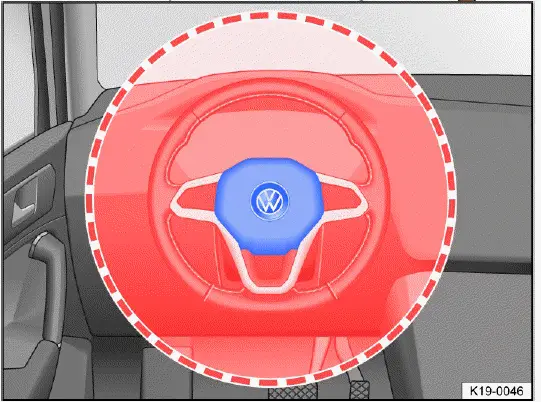
Fig. 30 On the driver's side: Installation location and deployment zone of
the driver's front airbag.
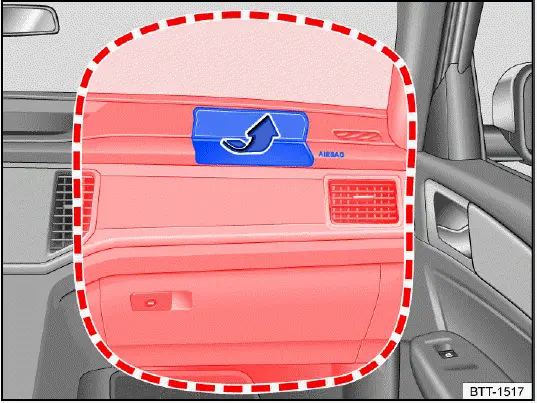
Fig. 31 On the passenger's side: Installation location and deployment zone of
the front passenger's front airbag.
As a supplement to the safety belts, the front airbag system offers additional protection for the head and chest regions of the driver and front passenger during frontal collisions with higher impact severity. In certain head-on collisions, the Side Curtain Protection airbags will also deploy on both sides.
Always maintain as much distance as possible to the front airbag ⇒ Seating position. This allows the front airbags to expand completely during collisions and thus provide maximum protection.
The front airbag for the driver is located in the steering wheel fig. 30 and the front airbag for the front passenger is located in the instrument panel fig. 31. The airbag installation locations are marked with the lettering "AIRBAG".
The area outlined in red defines where the front airbags will deploy (deployment
zones). Therefore, never place or attach
objects in these areas ⇒
 . The
attachments mounted at the factory will not be affected by the deployed driver's
and front
passenger's front airbag.
. The
attachments mounted at the factory will not be affected by the deployed driver's
and front
passenger's front airbag.
The front airbags do not deploy in the following situations:
- In case of crashes when the ignition is switched off.
- In side-on collisions.
- In case of a rear-end collision.
- If the vehicle rolls over.
- If the impact speed is too low.
The front passenger's front airbags do not deploy in the following situations:
- If the front passenger seat is not occupied.
- If the passenger seat recognition system recognizes that the front
passenger seat is unoccupied and the PASSENGER
AIR BAG
 indicator light comes
on.
indicator light comes
on.
WARNING
An airbag deploys within a few milliseconds and at a very high speed. This could result in objects being thrown through the vehicle interior. This may cause serious injuries.
- Always keep the deployment zones of the airbags clear.
- Never attach objects to the covers or in the deployment zones of airbags.
- There should be no people, animals, or objects between the vehicle
occupants and the airbag deployment zone.
Make sure that children and other passengers also follow this instruction.
- Do not attach any objects, such as mobile navigation systems, to the windshield above the front airbag on the passenger's side.
- Do not tape over or cover the installation locations of the airbags or the surfaces in the deployment zones of the airbags, or modify them in any other way.
WARNING
An incorrect seating position may prevent the front airbag from functioning properly and cause serious injuries.
- Always hold the steering wheel with both hands on the sides of the outer edge, in the nine o'clock and three o'clock position.
- Adjust the driver seat so that there is a distance of at least 25 cm (10 inches) between your chest and the center of the steering wheel. If body characteristics mean that this is not possible, you must contact an authorized Volkswagen dealer or authorized Volkswagen Service Facility. Volkswagen recommends contacting an authorized Volkswagen dealer or authorized Volkswagen Service Facility.
- Adjust the front passenger seat so that there is the greatest possible distance between the front passenger and the instrument panel.
Side airbags
Please read the introductory information and heed the Warnings and
Notice ⇒
 Introduction.
Introduction.
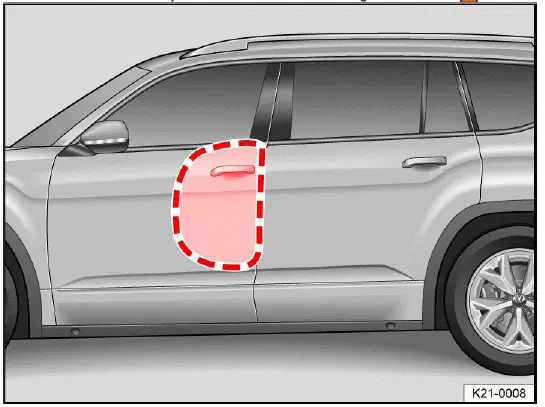
Fig. 32 In the vehicle interior on both sides of the vehicle: deployment zone
of the front side airbag.
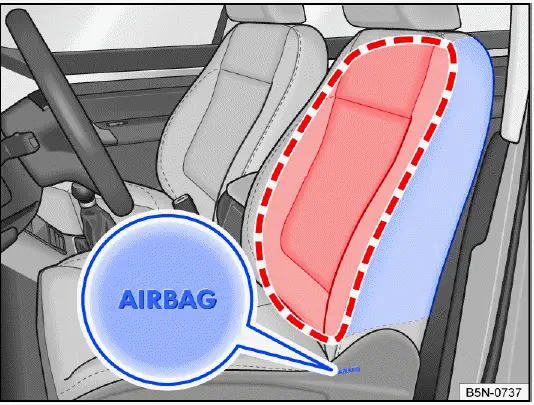
Fig. 33 On the side of the front seat: Side airbag installation location and
deployment zone
The installation locations of the side airbags are marked with the word "AIRBAG".
The area outlined in red defines where the side airbags will deploy (deployment
zones) fig. 33, fig. 32. Therefore, never
place or attach objects in these areas ⇒
 .
.
In the event of a side impact collision, the side airbags reduce the risk of injury to the vehicle occupants on the side of impact.
The Side Curtain Protection airbags will deploy on both sides.
WARNING
An airbag deploys within a few milliseconds and at a very high speed. This could result in objects being thrown through the vehicle interior. This may cause serious injuries.
- Always keep the deployment zones of the airbags clear.
- Only hang lightweight clothing from the garment hooks in the vehicle.
- Never store heavy or sharp-edged objects in pockets.
- Do not attach any accessories to the doors.
- Only use seat covers or protective covers that are specifically approved for use in your vehicle.
WARNING
Incorrect handling and use of the seats can inhibit the airbags from functioning correctly and cause serious injuries.
- Never remove the front seats from the vehicle or modify parts of them.
- Do not apply excessive force to the backrest bolsters.
- Only use seat covers or protective covers that are specifically approved for use in your vehicle.
- Have any damage to the seat covers or the seam in the airbag areas repaired immediately by suitably qualified professionals. Volkswagen recommends contacting an authorized Volkswagen dealer or authorized Volkswagen Service Facility.
Side Curtain Protection
Please read the introductory information and heed the Warnings and
Notice ⇒
 Introduction.
Introduction.
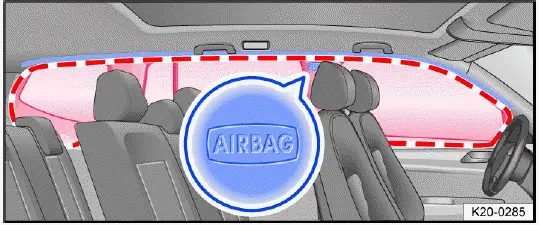
Fig. 34 On the left side of the vehicle: installation location and deployment
zone of the Side Curtain Protection.
Side Curtain Protection airbags are located on the driver's and passenger's side in the vehicle interior above the doors fig. 34.
The installation locations of the Side Curtain Protection are marked with the word "AIRBAG".
The area outlined in red defines where the Side Curtain Protection airbags
will deploy (deployment zone) fig. 34. Therefore,
never place or attach objects in this area ⇒
 .
.
In side collisions and certain head-on collisions, the Side Curtain Protection airbags will also deploy on both sides.
Side Curtain Protection airbags offer the "ejection mitigation" function, which protects the vehicle occupants and body parts from being completely or partially ejected from the vehicle in the event of a side impact collision or if the vehicle rolls over.
The Side Curtain Protection airbags reduce the risk of injury to vehicle occupants in the front and outer rear seats during a side collision and certain head-on collisions.
Side Curtain Protection airbags are composed of the following components:
- Control module and sensors.
- Side Curtain Protection airbags.
- Airbag indicator light ⇒ Indicator light for front passenger's front airbag.
The Side Curtain Protection airbags do not deploy in the following situations:
- In case of crashes when the ignition is switched off.
- In certain side collisions with a low force that does not trigger the sensor.
- In case of a rear-end collision.
- In the case of certain head-on collisions.
- In certain rollovers with a low momentum that do not trigger the sensor.
- If the impact speed is too low.
WARNING
An airbag deploys within a few milliseconds and at a very high speed. This could result in objects being thrown through the vehicle interior. This may cause serious injuries.
- Always keep the deployment zones of the airbags clear.
- Never attach objects to the covers or in the deployment zones of airbags.
- There should be no people, animals, or objects between the vehicle
occupants and the airbag deployment zone.
Make sure that children and other passengers also follow this instruction.
- Only hang lightweight clothing from the garment hooks in the vehicle. Never store heavy or sharp-edged objects in pockets.
- Do not attach any accessories to the doors.
- Do not attach any sunshades to the side windows that are not specifically approved for use in the vehicle.
- Only pivot sunshades toward the side windows if no objects such as pens or garage door openers are attached to the visor.
Transporting children safely
Introduction
The physical principles in the event of an accident also apply to children. However, due to their size and other factors, they face a greater risk of injury.
Children and babies must therefore always be transported in child restraint systems that are designed for their age, size, weight and body structure. In the USA and Canada, the use of tested and certified child restraint systems is required by law.
In the case of head-on collisions at speeds of between 30 and 55 km/h
(approx. 20-35 mph), a small child weighing 6 kg (13
lbs) will be subjected to forces of more than 20 times their body weight. This
means that the child's effective weight will
suddenly increase to up to 120 kg (260 lbs). Under such conditions, only a child
restraint used in accordance with regulations
can reduce the risk of injury. However, a child restraint which is not used in
accordance with regulations may further increase
the risk of injury!
All children (particularly children under 12 years of age) should always be
transported on the rear seats in appropriate child
restraint systems. However, if you must use a child restraint on the front
passenger seat in exceptional circumstances, always
follow all the information and warnings available at ⇒
 Introduction.
Introduction.
You can find more information on this subject at:
National Highway Traffic Safety Administration (NHTSA) (USA): http://www.safercar.gov
Transport Canada Information Centre (Kanada): http://www.tc.gc.ca
Read and follow the instructions from the child seat manufacturer to ensure that the seat is appropriate for your child. Also be sure to read and follow all the information and warnings on child restraint systems in this manual!
WARNING
Even though the Advanced Airbag System is designed to detect child restraint systems on the front passenger seat and to switch off the front passenger's front airbag, it is not possible to guarantee that the system will perform correctly under all circumstances and over the vehicle's service life. In the event of an accident, people sitting on the front passenger seat (particularly children and small children) may suffer serious injuries or death if there is insufficient distance between them and the airbag when it is deployed (even with the Advanced Airbag System)!
- Always place children on the rear seats. This is the safest place for a child. A suitable child restraint that is installed on the rear seat in accordance with regulations provides the highest level of protection for children and small children in most accidents.
- In compliance with the "low risk" option for children of 3-6 years of age according to the U.S. Federal Standard, the Advanced Airbag System may be deployed if the electrical capacity of a typical one-year-old child combined with a child restraint system on the front passenger seat is exceeded and the criteria for deployment of the Advanced Airbag System are met.
WARNING
Accident statistics have shown that the rear seats offer greater safety than the front seats for children in general.
- Always transport children under 12 years of age on the rear seats.
- A child who is not secured or is not secured properly can be injured through sliding around in the vehicle interior or through being ejected from the vehicle during a sudden maneuver or collision. Secure children in the vehicle with a child restraint that is appropriate for their weight and height and with the safety belt used correctly ⇒ Transporting children safely.
- A child who is not secured or not properly secured is exposed to an increased risk of injury or death through collision with an airbag. Make sure that children are not within the deployment zone of the airbag.
- A child restraint system corresponding to body weight and body size that is installed and used on the rear seats offers maximum protection for infants and small children in most accident situations.
Child restraints - overview
Please read the introductory information and heed the Warnings and
Notice ⇒
 Introduction.
Introduction.
All children (particularly small children and infants) must be transported in child restraints suitable for them. These child restraints must always be installed correctly. The information in the following table will help you to find the suitable child restraint for your child.
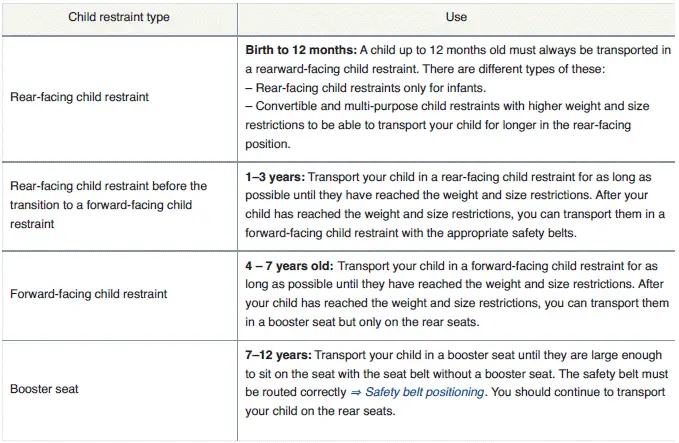
Child restraints can be fastened either with a three-point safety belt or with an ISOFIX/lower LATCH fastening system. Many child restraints also require the use of top tether systems. Depending on countries and federal states, the use of Top Tether may even be required by law.
How to determine whether a child restraint is installed correctly
- The child restraint sits flush with the seat cushion and the backrest, unless the manufacturer of the child restraint permits a gap between the seat and the child restraint.
- The overhang of the child restraint on the seat cushion is not longer than 20% of the child restraint. Always follow the instructions for the permitted child restraint overhangs.
- You should always position the child restraint centrally on the seat.
- The clearance of the child restraint forward and sideways is no greater than approximately 2.5 cm (1 inch).
- The child restraint must not rest on the belt buckles of the seats. These could be damaged as a result.
- When installing multiple child restraints, they must not block each other and must be free-standing and remain accessible.
- The child restraint has been secured correctly using the three-point
safety belt or ISOFIX/lower LATCH anchorage point.
The top tether system of the child restraint has also been used correctly as specified by the manufacturer.
DANGER
Children sitting on the front seats may suffer severe or fatal injuries in the event of airbag deployment (even if advanced airbags are used). Not using the child restraint, using it incorrectly or using the wrong child restraint increases the risk of severe injury or death in the event of an accident.
- Always install child restraints on the rear seats.
- If, in exceptional circumstances, you nevertheless install a child
restraint on the front passenger seat and the
yellow
 PASSENGER AIR BAG
indicator light does not come on and stay on, remove the seat immediately
and have the airbag system checked by an authorized Volkswagen dealer or
authorized Volkswagen Service
Facility. Volkswagen recommends contacting an authorized Volkswagen dealer
or authorized Volkswagen Service
Facility.
PASSENGER AIR BAG
indicator light does not come on and stay on, remove the seat immediately
and have the airbag system checked by an authorized Volkswagen dealer or
authorized Volkswagen Service
Facility. Volkswagen recommends contacting an authorized Volkswagen dealer
or authorized Volkswagen Service
Facility.
WARNING
If the airbag is deployed, a child restraint on the front passenger seat may collide with the airbag and the child in the child restraint may suffer severe or even fatal injuries (even if advanced airbags are used).
- If you nevertheless install a child restraint on the front passenger seat in exceptional circumstances, always ensure that the child restraint in use has been approved by the manufacturer for use on the front passenger seat.
- Read and always follow the child seat manufacturer's instructions.
- Never install a child restraint without the top tether safety belt if the use of a top tether safety belt is prescribed by the child restraint manufacturer or legally required for the child restraint.
- Never position a forward-facing child restraint directly against the instrument panel.
- Adjust the seat belt adjuster so that the seat can be installed correctly.
- Position the front passenger seat as high as possible and move it as far back as possible in order to obtain the largest possible distance to the instrument panel.
- Make sure that the upper anchorage of the safety belt is behind the child restraint to ensure that the safety belt is routed correctly.
- Make sue that the backrest is in the upright position.
WARNING
A child that is in a child restraint that has been secured with the anchor points or with a safety belt may play with any unused safety belts on the rear seat and get tangled up, which could result in serious or even fatal injuries.
- Always secure unused safety belts to the rear seat. You can do this by putting them around the head restraints which are furthest away from the installed child restraint and properly securing the safety belt.
NOTICE
Improper use of the lockable safety belt can cause damage to the safety belt.
- Make sure that you do not activate the lockable belt system when you secure the safety belts that are not being used.
- Always ensure that you correctly and carefully install a child restraint with the safety belt.
Safety notes on using child restraints
Please read the introductory information and heed the Warnings and
Notice ⇒
 Introduction.
Introduction.
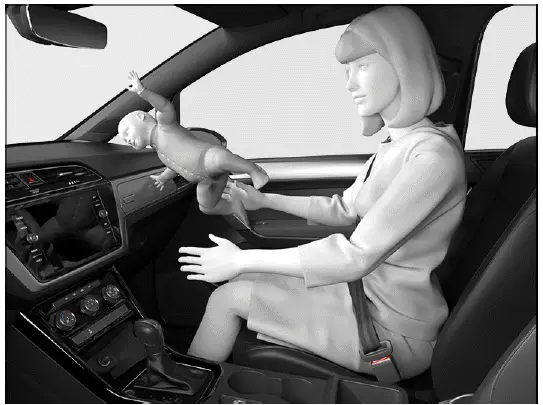
Fig. 35 Danger to infants not wearing safety belts.
The correct use of child restraints significantly reduces the risk of injury in the event of an accident or collision!
All children, in particular children under the age of 12, must always travel in suitable child restraints on the rear seat.
Only use child restraints that are suitable for the height and weight of the child.
ISOFIX/lower LATCH anchorage points can be used to secure child restraints on the seats without using the vehicle's safety belts. If, despite this, you want to install a child restraint with the safety belts instead of ISOFIX/lower LATCH anchorage points, follow all the instructions given by the child restraint manufacturer for the belt guide and for securing the child in the child restraint. Ensure that the child restraint cannot move forward or sideways by more than 2.5 cm (1 inch) after installation.
When installing a child restraint with the safety belt, you must activate the lockable belt system.
Never activate the lockable belt system when installing a booster seat or if a child is traveling without a child restraint.
Once the child restraint is correctly installed, the settings for that seat must no longer be changed. If the seat settings have been changed, the installation of the child restraint must be checked and, if necessary, adjusted.
If a child restraint is installed on a seat, functions such as the massage function or seat heating ⇒ Using Seat Heating and Seat Ventilation must not be used on that seat.
Important additional information for installing child restraints on the front passenger seat
If, under exceptional circumstances, you need to install a child restraint on
the front passenger seat, read and follow all
warnings and instructions here ⇒
 Introduction.
Introduction.
You can find additional information on the selection and use of child restraints here:
Transport Canada Information CentreTel.: 1-800-333-0371Tel.: 1-613-998-8616 (Ottawa)http://www.tc.gc.ca/roadsafety
National Highway Traffic Safety AdministrationTel.: 1-888-327-4236 (TTY: 1-800-424- 9153)http://www.nhtsa.govhttp://www.safercar.gov
National SAFE KIDS CampaignTel.: 1-202-662-0600http://www.safekids.org
SafetyBeltSafe U.S.A.Tel.: 1-800-745-SAFE or 1-800-745-7233 (English)Tel.: 1-800-747-SANO or 1-800-747-7266 (Spanish)http://www.carseat.org
Volkswagen Customer CARETel.: 1-800-822-8987
DANGER
The use of rear-facing child restraints or infant carriers on the front passenger seat can cause serious or fatal injury.
- Rear-facing child restraints or infant carriers must always be installed on the rear seats.
WARNING
Transporting children without a child restraint or with an unsuitable child restraint, or incorrectly installing a child restraint, increases the risk of severe injury or death in the event of an accident.
- Only use child restraints that are suitable for the child and that comply with the regulations set out by FMVSS 213 (CMVSS 213 in Canada).
- Only use child restraints that sit on the seat cushion of the vehicle.
- When installing the child restraint, follow the instructions given by the manufacturer of the child restraint.
- Always observe all legal requirements regarding the installation and use of child restraints.
- Children under 145 cm (around 4 ft, 9 in) may only be secured and transported in the vehicle with an appropriate child restraint.
- Only one child must be allowed to travel in a child restraint.
- Never drive with children, toddlers or babies on your own lap or another passenger's lap.
WARNING
Forward-facing child restraints on the front passenger seat may collide with the airbag if it is triggered, which can lead to severe injury or death.
- Always install child restraints on the rear seat.
Securing systems
Please read the introductory information and heed the Warnings and
Notice ⇒
 Introduction.
Introduction.
Different securing systems are used for safe installation of child restraints depending on the country.
Only use the securing systems described here to secure child restraints in the vehicle.
Overview of securing systems
- ISOFIX/lower LATCH anchorage points: ISOFIX/lower LATCH anchorage points are attachment systems for quick and secure attachment of child restraints in the vehicle. Attachment using ISOFIX/lower LATCH anchorage points creates a fixed connection between the child restraint and the vehicle.
The child restraint can have two fixed or flexible attachment arms. The attachment arms snap into the ISOFIX/lower LATCH anchorage points that are located between the seat cushion and the rear seat backrest ⇒ Fastening a Child Restraint with ISOFIX or Lower LATCH Anchorage Point. Reinforce the attachment using the ISOFIX/lower LATCH anchorage points by attaching with a top tether safety belt or a support bracket, if necessary.
- Three-point safety belt : Child restraints can be fastened with a three-point safety belt ⇒ Securing a child restraint with a safety belt.
Additional fasteners:
- Top Tether: the upper belt is guided over the rear seat backrest and secured to the anchorage point on the rear side of the rear seats using a hook ⇒ Securing the child restraint with the upper strap (top tether). Top tether anchorages are labeled with an anchor symbol.
- Support base: some child restraints are supported with a support base on
the vehicle floor. The support base reduces
the risk of the child restraint tipping forward in the event of a collision.
Only use child restraints with a support foot on the
front passenger seat and the outer seats in the second row of seats ⇒
 .
.
WARNING
Incorrect use of the support base can cause severe or fatal injuries.
- Make sure the support base is installed correctly and securely.
- Always refer to and follow the installation instructions and warnings from the child restraint manufacturer.
Fastening a Child Restraint with ISOFIX or Lower LATCH Anchorage Point
Please read the introductory information and heed the Warnings and
Notice ⇒
 Introduction.
Introduction.
Installing child restraints with ISOFIX/lower LATCH anchorage point
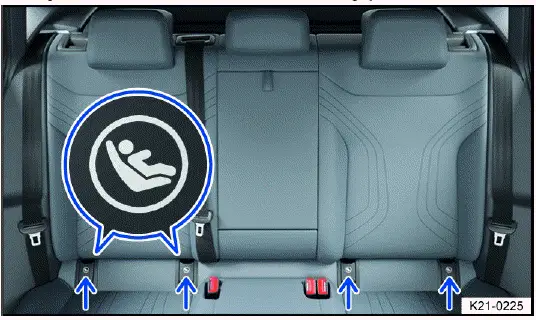
Fig. 36 On the outer seats in the rear bench seat: Designation of the
ISOFIX/lower LATCH anchorage points for child
restraints.
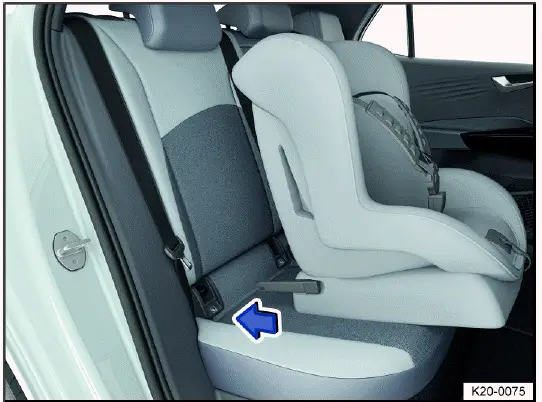
Fig. 37 Fitting a child restraint with arms (general example).
The installation location of the ISOFIX/lower LATCH anchorage points is indicated by a symbol fig. 36.
1. Pay attention to and follow the information → page, Safety notes on using child restraints.
2. If necessary, fold down the protective caps of the ISOFIX/lower LATCH anchorage points.
3. Push the attachment arms of the child restraint in the direction of the arrow onto the ISOFIX/lower LATCH anchorage points fig. 37. The child restraint must engage securely and audibly.
4. Pull on both sides of the child restraint to check that the child restraint is securely locked in place.
If the child restraint is equipped with a support foot, this support foot must be positioned securely on the vehicle floor.
Securing the child restraint with the upper strap (top tether)
Please read the introductory information and heed the Warnings and
Notice ⇒
 Introduction.
Introduction.
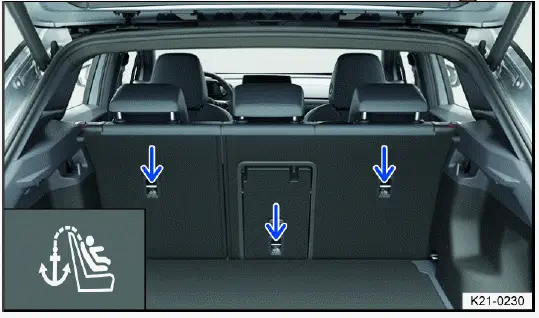
Fig. 38 On the rear side of the rear bench seat: Top tether anchorages for
the top tether safety belt.
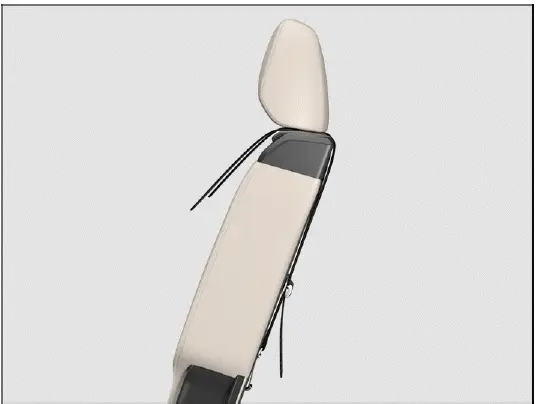
Fig. 39 On the rear side of the rear bench seat: attached top tether safety
belt.
Top tether safety belts reduce the forward movement of the child restraint during an accident. This reduces the risk of a head injury to the child.
The anchorages suitable for top tether are labeled with a symbol and may have the label "TOP TETHER" fig. 38. Fasten the top tether safety belt only to the top tether anchorages designed for this purpose.
Fastening the top tether safety belt
1. Pay attention to and follow the information → page, Safety notes on using child restraints.
2. Prepare the top tether safety belt on the child restraint according to the
child restraint manufacturer instructions ⇒
 .
.
3. If necessary, remove the luggage compartment cover and screen separator.
4. Place the child restraint in the center of the vehicle seat cushion and fasten it securely according to the child restraint manufacturer instructions.
5. If necessary, move the rear seat backrest of the vehicle seat to an upright position and adjust to the backrest of the child restraint.
6. Locate the top tether anchorage for the respective seat fig. 38.
7. If necessary, push the head restraint upwards and guide the top tether safety belt of the child restraint to the rear under the head restraint.
Applies to child restraints with a V-shaped top tether safety belt: Check that the top tether safety belt is taut on the seat and is not redirected by the bars of the head restraint.
8. Guide the top tether safety belt of the child restraint back over the seat.
9. Hook the top tether safety belt into the appropriate anchorage marked with "top tether" fig. 39.
10. Pull on the top tether safety belt.
11. Check that the hook of the top tether safety belt is closed.
12. Tighten the top tether safety belt according to the child restraint
manufacturer instructions ⇒
 .
.
13. If necessary, guide the head restraint back into the starting position.
WARNING
Fastening the child restraint incorrectly increases the risk of serious and fatal injuries during an accident.
- Always follow the child restraint manufacturer instructions for fastening the child restraint in the vehicle.
- Never fasten a child restraint without the top tether safety belt if
the use of a top tether safety belt is prescribed by
the child restraint manufacturer or legally required for the child
restraint.
For example, the use of a top tether safety belt in conjunction with a forward-facing child restraint is legally required in Canada.
- Improper fastening of the top tether safety belt can lead to serious injuries during an accident. The top tether anchorages are only approved for correctly installed child restraints.
- Always only fasten a top tether safety belt of a child restraint to a top tether anchorage.
- Never fasten a child restraint top tether safety belt to a tie-down.
- Never fasten a safety belt or another belt of the child restraint to a top tether anchorage.
- Never fasten luggage or other objects to a top tether anchorage.
Releasing the top tether safety belt
1. Release the top tether safety belt according to the child restraint manufacturer instructions.
2. Release the catch on the hook and release the top tether safety belt from the top tether anchorage.
Securing a child restraint with a safety belt
Please read the introductory information and heed the Warnings and
Notice ⇒
 Introduction.
Introduction.
Locking the safety belt
If a child restraint is fastened with a safety belt, the safety belt must be locked. Note the instructions provided by the child restraint manufacturer.
If a safety belt is locked, the belt cannot unwind. A locked safety belt prevents the safety belt being released during the journey, which can mean that the child restraint is no longer sufficiently secured.
1. Pay attention to and follow the information → page, Safety notes on using child restraints.
2. If available, adjust the height of the safety belt so that the belt webbing runs naturally along the child restraint without any sharp bends in the webbing.
3. Install the child restraint according to the guide from the child restraint manufacturer and ensure that the safety belt meant for the seat is used.
4. Insert the buckle tongue into the belt buckle belonging to the corresponding seat, until the buckle tongue latches into place.
5. Check that the safety belt is not twisted.
6. Check that the lap section of the safety belt is taut.
7. Completely pull out the shoulder belt section of the safety belt and then let it gently roll up.
While the safety belt is being rolled up, a clicking sound can be heard. Once the safety belt is locked, it cannot be further pulled out.
8. Press the child restraint into the seat and let the safety belt roll up further. If necessary, return the shoulder belt section of the safety belt to the automatic safety belt retractor by hand.
9. Pull the belt guide of the child restraint.
Check that the child restraint cannot move further than 2.5 cm (approx. 1 inch).
Releasing the locked safety belt
The lockable safety belt may only be used to fasten certain child restraint systems in the vehicle. An activated locking mechanism must be released when a vehicle occupant fastens their safety belt.
1. Release the safety belt from the belt buckle.
2. Remove the child restraint according to the instructions from the child restraint manufacturer.
3. Press the red button in the belt buckle and guide the safety belt back fully by hand.
The safety belt is no longer locked.
Keep any safety belts that are not being used out of the reach of children
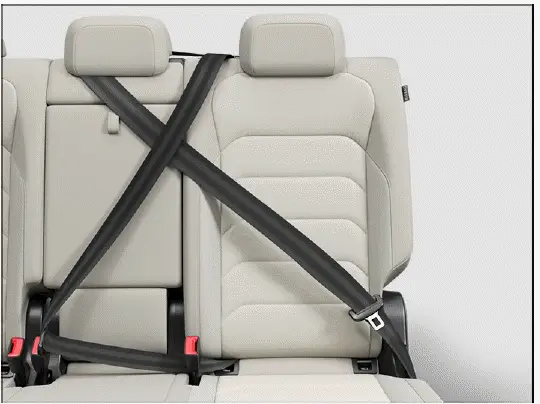
Fig. 40 Securing unused safety belts (general example).
Secure any safety belts not being used to prevent a child from playing with the safety belt and getting caught in it. The procedure for securing a safety belt that is not being used depends on the seating position.
To secure a safety belt that is not being used for one of the outer seats:
1. Position the safety belt around the head restraint of the center seating position fig. 40.
2. Make sure that the safety belt is out of range of any children so that children cannot touch it or play with it.
3. Make sure that the safety belt is not blocking the lower anchors.
If the anchor points are blocked, this may mean that you cannot install the child restraint properly in the anchor points.
4. Do not activate the lockable safety belt.
Otherwise, it is very difficult to retract the safety belt into its normal position. You should not hear any clicking noises when the safety belt is retracted.
To secure a safety belt that is not being used for the middle seat:
1. Insert the buckle tongue of the safety belt in the belt buckle belonging to the seat fig. 40.
2. Pull the shoulder strap on the safety belt out fully to activate the lockable safety belt. You should hear a clicking noise when the safety belt is rolled up again.
3. Let the safety belt roll up fully. Pull the safety belt to make sure that the lockable safety belt is activated and the safety belt is properly fastened and tightened so that the child cannot get hold of the belt or play with it.
If a child is secured on a seat in the second row, adjust the position in front of the child restraint to ensure that the child has enough space. For example, adjust the front passenger seat to the size of the child and the child directly behind them. Always pay attention to the correct seating position ⇒ Seating position.
if no child restraints are needed, move all the safety belts back into their normal storage positions so that the safety belts are available for normal use.
Installing on the center seating position
When installing a child restraint on the center seating position, it is especially important to install correctly because this seating position is narrower than both of the outer seats. If the child restraint is wider than the seat surface, the belt buckle of the adjacent seating position may be covered and could then be damaged. When installing child seats, always ensure that all belt buckles are easily accessible.
- If nothing else is specified by the child restraint manufacturer, the child restraint must rest close against the backrest and seat surface and must not overlap seat surfaces.
- The child restraint must be installed straight and centered on the seating position, and it must not be able to move more than 2.5 cm (approx. 1 inch).
- The child restraint must not rest on the belt buckles.
- When installing multiple child restraints, the child restraints must not become caught on one another.
In some cases, even if a child restraint is installed correctly on the center seating position, it may cover the belt buckles and could then damage them and make the belt buckles unusable. This can occur if the child restraint slides on the seat surface while driving. Therefore, check the position of the child restraint regularly to ensure that the belt buckles are neither covered nor damaged.
WARNING
A child that is in a child restraint that has been secured with the anchor points or with a safety belt may play with any unused safety belts on the rear seat and get tangled up, which could result in serious or even fatal injuries.
- Always keep any safety belts for the rear seats that are not being used out of the reach of children.
Securing a booster seat with a safety belt
Please read the introductory information and heed the Warnings and
Notice ⇒
 Introduction.
Introduction.
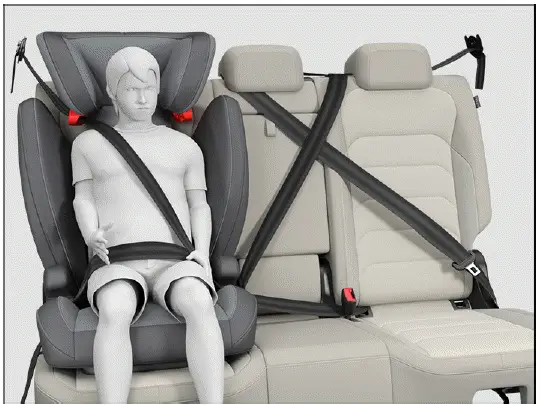
Fig. 41 Correctly fastened child on a booster seat (general example).
Children between the ages of around 8 and 12 are best protected when they travel on a booster seat that is suitable for their age and height.
The safety belts of the vehicle generally only fit children 145 cm (approx. 4 ft, 9 in) tall or taller. Booster seats ensure that children under this height can be correctly fastened using the safety belt.
- Never activate the lockable belt system when securing children on a booster seat with a belt.
- The upper area of the belt must always be positioned on the child's shoulder. Ensure that the belt does not rest on the child's face or neck.
- The lap belt must always run across the child's lap. It must never run across the child's stomach.
Children above 145 cm (approx. 4 ft, 9 in) can generally always be secured with the safety belt. Pay attention to the information at ⇒ Safety belt positioning.
Your child no longer needs a booster seat if they are taller than 145 cm (approx. 4 ft, 9 in) and the following conditions are met:
- The child is seated with their back fully against the backrest.
- The child's knees bend over the edge of the seat.
- The child's feet sit fully flat on the vehicle floor.
- The child can comfortably stay in this position for the entire journey.
Children aged 12 or under must always travel on a rear seat.
WARNING
Not using or incorrectly using a booster seat or incorrectly fastening a safety belt can result in severe injury or death in the event of an accident.
- Always observe all instructions regarding the installation and use of child restraints and booster seats.
- If, under exceptional circumstances, you need to install a booster
seat on the front passenger seat, ensure that the PASSENGER AIR BAG
 indicator light turns on and
remains on.
indicator light turns on and
remains on.
In case of an emergency
Securing yourself and the vehicle
Follow all legal regulations regarding securing a vehicle during a breakdown. For example, in many countries you must switch on the emergency flashers and wear a reflective vest ⇒ Emergency equipment.
Checklist of what to do in the event of a breakdown
For your own safety and the safety of your passengers, follow the points below in the order they are given:
1. Park your vehicle a safe distance from traffic and on suitable ground.
Observe all important information on parking when
doing so ⇒
 , ⇒ Parking.
, ⇒ Parking.
2. Switch on the emergency flashers ⇒ Center console.
3. Have all vehicle occupants exit the vehicle on the side facing away from traffic and move to a safe area, such as behind a guard rail. Follow the local regulations regarding wearing a reflective vest.
4. Set up the warning triangle to warn others on the road about the vehicle.
5. Observe the safety instructions → page, Safety precautions for working in the engine compartment.
6. If necessary, contact an authorized Volkswagen dealer or authorized Volkswagen Service Facility for assistance.
Volkswagen recommends contacting the Volkswagen emergency assistance service.
When the emergency flashers are switched on, for example while towing the vehicle, you can indicate any turns or lane changes using the turn signal lever. The emergency flashers will stop temporarily.
Read and observe the important information about towing ⇒
 Introduction.
Introduction.
WARNING
A stalled vehicle increases the risk of a crash that could cause injury to you, your vehicle occupants, or others on the road.
- Stop the vehicle as soon as it is safe to do so.
- Park the vehicle a safe distance from moving traffic.
- Switch on the emergency flashers.
- Never leave any persons, particularly children or people requiring assistance, in the vehicle. This is especially true when the doors are locked. Individuals locked in the vehicle could be exposed to very high or very low temperatures.
WARNING
Exhaust system components will become very hot. This can result in fires and serious injuries.
- Never park the vehicle in such a way so that any exhaust system components could come into contact with flammable materials under the vehicle such as dry grass or fuel.
NOTICE
Pushing the vehicle by hand may cause damage to the vehicle or cause the rear spoiler to detach.
- When pushing the vehicle by hand, make sure that you do not apply any pressure to the taillights, the rear spoiler or large sheet metal surfaces.
Checklist of what to do after an accident
In the event of an accident, for your own safety and the safety of your passengers, follow the points below in the order in which they are given:
1. Switch the ignition off.
2. Switch on the emergency flashers
 ⇒ Center console.
⇒ Center console.
3. Set up the warning triangle to warn others on the road about the vehicle.
4. Have all vehicle occupants exit the vehicle on the side facing away from traffic and move to a safe area, such as behind a guard rail. Provide first aid and follow the local regulations regarding wearing a reflective vest.
5. Report the accident to the fire department.
6. Wait at the location of the accident for the rescue services to arrive.
Switch on the emergency flashers in the following situations, for example:
- To warn traffic behind your vehicle if the traffic ahead slows suddenly or you reach the end of a traffic jam.
- If there has been an accident.
- If the vehicle malfunctions.
- When towing the vehicle.
Always follow the applicable local requirements for use of the emergency flashers.
If the emergency flashers do not work, others on the road must be informed about the stalled vehicle in some other way that meets the applicable legal regulations.
 The 12 V vehicle battery will
drain if the emergency flashers remain on for a long period of time, even if the
ignition is
switched off.
The 12 V vehicle battery will
drain if the emergency flashers remain on for a long period of time, even if the
ignition is
switched off.
 Depending on vehicle
equipment, the brake lights may blink quickly if you brake hard while driving at
speeds above
approx. 80 km/h (approx. 50 mph) or brake the vehicle to a complete stop. This
is done to warn traffic behind your vehicle.
Depending on vehicle
equipment, the brake lights may blink quickly if you brake hard while driving at
speeds above
approx. 80 km/h (approx. 50 mph) or brake the vehicle to a complete stop. This
is done to warn traffic behind your vehicle.
If the braking continues, the emergency flashers will switch on automatically when the vehicle speed is below approx.
10 km/h (approx. 6 mph). The emergency flashers will switch off automatically when you accelerate.
Emergency equipment
First aid kit
Depending on the country and the vehicle equipment, the first aid kit may be located in a storage compartment, in a holder in the luggage compartment, under the luggage compartment floor, or in the vehicle interior.
The first aid kit must meet the legal regulations.
- Note the expiration date of the contents.
- Replace contents after use, if necessary, and put the first aid kit securely back into place.
Warning triangle
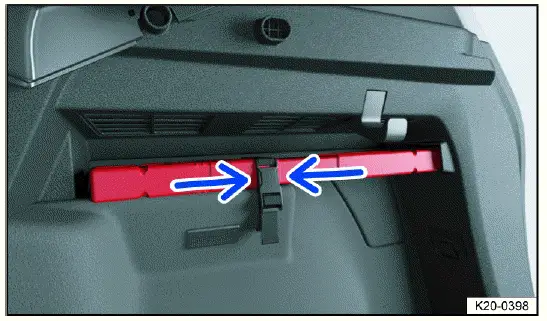
Fig. 42 In the luggage compartment on the right-hand side: Holder for the
warning triangle.
Depending on the country and the vehicle equipment, the warning triangle may be located in the luggage compartment on the right-hand side.
1. Squeeze the catch on both sides fig. 42 (arrows) and remove the sleeve of the warning triangle from the holder.
2. After use, store the warning triangle back in the sleeve and insert the sleeve back into the holder.
The warning triangle must meet the legal regulations.
Reflective vest
Depending on the vehicle equipment and country of use, the safety vest may be in a storage compartment in the front door trim panel or in the glove compartment ⇒ Driver door, ⇒ Passenger's side.
The reflective vest must meet the legal regulations.
Fire extinguisher
Depending on the vehicle equipment and country of use, a fire extinguisher may be located in a holder in the footwell under the front passenger seat.
The fire extinguisher must meet the legal regulations, always be ready to operate, and be checked regularly - see inspection seal on the fire extinguisher.
WARNING
Objects that are loose or secured incorrectly can be thrown around the vehicle interior during sudden driving or braking maneuvers or in a collision and cause serious injuries.
- Always position the first aid kit, warning triangle and fire extinguisher securely in the holders provided in the vehicle.
- tore the reflective vest in a storage compartment so that it is easy to access.
Information Call, Roadside Assistance Call and Emergency Call Service
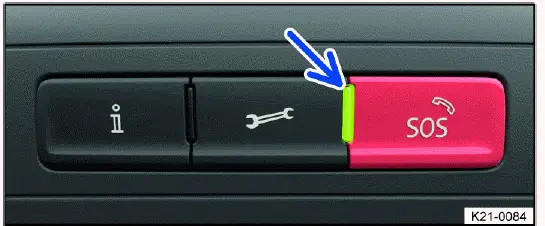
Fig. 43 In the roof console: Controls for call services and indicator light.
 Information call.
Information call.
 Roadside assistance call.
Roadside assistance call.
 Emergency Call Service.
Emergency Call Service.
The control in the roof console fig. 43 can be used for voice services, depending on the vehicle equipment and country of use.
The required connection is produced by a control module installed by the manufacturer.
 Note the additional
information on VW Car-Net.
Note the additional
information on VW Car-Net.
Indicator lights for the Emergency Call Service
An indicator light fig. 43 (arrow) for voice and data transmission services is located in the control panel. The indicator light comes on in different colors and light patterns depending on the vehicle operating status of the Emergency Call Service:
 The indicator light does not
light up:
The indicator light does not
light up:
 The vehicle is offline
and has no connectivity. The red indicator light comes on and
remains on: system error. The Emergency Call Service is limited or not
available.
The vehicle is offline
and has no connectivity. The red indicator light comes on and
remains on: system error. The Emergency Call Service is limited or not
available.
 The green indicator
light lights up:
Displays the availability of mobile radio signal. Does not display whether VW
Car-Net services have been purchased and
are active, except for the Emergency Call Service.
The green indicator
light lights up:
Displays the availability of mobile radio signal. Does not display whether VW
Car-Net services have been purchased and
are active, except for the Emergency Call Service.
 The indicator light blinks green:
there is a call in progress.
The indicator light blinks green:
there is a call in progress.
Information call
- With an information call, a call can be made to the VW Car-Net call center for questions regarding VW Car-Net services.
- The information call is only available in certain sales regions.
- The information call can be executed whenever the ignition of the vehicle is switched on.
- The information call can be manually executed with the control panel in the roof console or the function key in the telephone menu of the Infotainment system.
Roadside assistance call
- If you break down, you can contact an authorized Volkswagen dealer or authorized Volkswagen Service Facility for assistance with the roadside assistance call.
- Some vehicle data, e.g. its current location, is transferred in parallel to the voice call.
- The Roadside Assistance Call can be executed whenever the ignition of the vehicle is switched on.
- Roadside Call Assist can be manually executed with the control panel in the roof console or the function key in the telephone menu of the Infotainment system.
Emergency Call Service
- Using the Emergency Call Service, assistance can be organized as quickly as possible in dangerous situations.
- The Emergency Call Service is only available if a corresponding license is acquired.
- If the Emergency Call Service is triggered, a call to the VW Car-Net call center will be made.
- If an emergency call is triggered manually or by a collision with airbag deployment or safety belt pretensioner deployment, data that is relevant to the emergency call, such as the vehicle's current location, is automatically transmitted ⇒ Customer information.
- The contact partner will communicate in the language that is set in the vehicle's Infotainment system. If this language is not available at the current emergency call location, English will be used.
WARNING
The following conditions may restrict or prevent a manual or automatic emergency call:
- The emergency call location is in an area with no cell phone and satellite reception, or insufficient reception.
- You are in a location where there is sufficient mobile phone and satellite reception, but the telecommunications provider's mobile communications network is unavailable.
- The Emergency Call Service is not permitted by law in some countries.
- VW Car-Net has not been activated.
- No valid license for the use of the Emergency Call Service has been acquired or the license has expired.
- The vehicle components required for manual or automatic emergency calls are damaged or do not have sufficient power.
- The vehicle's ignition is not switched on.
Triggering an emergency call manually
1. If fitted, press on the button cover briefly and fold the cover downward.
2. Press the emergency call button fig. 43 until the green indicator light starts to flash.
The emergency call is triggered and a voice call to the VW Car-Net call center is established.
If you pressed the emergency call button by mistake, cancel the emergency call immediately:
1. Press the emergency call button again until the indicator light remains green.
Automatic emergency call
The automatic emergency call is only triggered when the ignition is on.
A connection to the VW Car-Net response center is automatically established in the following situations:
- Immediately after the airbags have been deployed.
- Immediately after the safety belt pretensioners have been triggered.
- Depending on the vehicle equipment, in the event of a system intervention by the Emergency Assist system.
The automatic emergency call cannot be stopped by pressing the emergency call button fig. 43.
If questions from the VW Car-Net call center remain unanswered, rescue operations will automatically start.
Integrated battery
The integrated battery ensures that the Emergency Call Service will still be available for some time if the 12 V vehicle battery is disconnected or faulty.
If the integrated battery is drained or faulty, a message indicating this will be displayed in the instrument cluster. If this message is shown, immediately consult an authorized Volkswagen dealer or authorized Volkswagen Service Facility and have the integrated battery replaced. Volkswagen recommends contacting an authorized Volkswagen dealer or authorized Volkswagen Service Facility.
 Have the integrated battery
checked, and if necessary, replaced by an authorized Volkswagen dealer or
authorized
Volkswagen Service Facility after approximately three years. Volkswagen
recommends contacting an authorized
Volkswagen dealer or authorized Volkswagen Service Facility.
Have the integrated battery
checked, and if necessary, replaced by an authorized Volkswagen dealer or
authorized
Volkswagen Service Facility after approximately three years. Volkswagen
recommends contacting an authorized
Volkswagen dealer or authorized Volkswagen Service Facility.
Data transmission
The available data will be sent to the VW Car-Net call center during an emergency call to determine what rescue measures are needed.
The data regarding the location of the vehicle is continuously overwritten, so that only the ten most recent saved locations as required for the Emergency Call Service to function are available. The vehicle cannot be tracked on a continuous basis.
The emergency call data is only processed to ensure the proper function of the Emergency Call Service.
The following data will be sent:
- The current vehicle position at the time the emergency call was triggered
- Nine other positions shortly before the emergency call was triggered (route driven, a few km (a few mi)).
- Vehicle Identification Number (VIN)
- Type of vehicle drive.
- Vehicle model
- Trigger type (automatic or manual)
- Call type.
- Direction in which the vehicle was moving at the time the emergency call was triggered.
- Accident severity.
- Accident direction.
- Time of impact
- Reliability of the positioning data
- Data set version.
- Counter of the data sets transmitted per call
- Calculated number of passengers.
- Language selected in the Infotainment system.
- Optional data ID.
 The Emergency Call Service
function may be limited by any after-market Infotainment systems that are
installed.
The Emergency Call Service
function may be limited by any after-market Infotainment systems that are
installed.
Troubleshooting
 Emergency Call Service
malfunction
Emergency Call Service
malfunction
The red indicator light in the emergency call button comes on and remains on
 . The message
. The message
 Error: Emergency call
function. Service vehicle may also be displayed in the instrument cluster.
Error: Emergency call
function. Service vehicle may also be displayed in the instrument cluster.
There is a system error with the Emergency Call Service. You may not be able to make an emergency call.
1. Contact an authorized Volkswagen dealer or authorized Volkswagen Service Facility immediately and have the fault rectified. Volkswagen recommends contacting an authorized Volkswagen dealer or authorized Volkswagen Service Facility.
 Emergency Call Service
limited
Emergency Call Service
limited
The red indicator light in the emergency call button comes on and remains on
 . The message
. The message
 Emergency call function
limited. Service vehicle may also be displayed in the instrument cluster.
Emergency call function
limited. Service vehicle may also be displayed in the instrument cluster.
The Emergency Call Service function has restricted availability. For example, you cannot make a voice call to the VW Car- Net call center.
1. Contact an authorized Volkswagen dealer or authorized Volkswagen Service Facility immediately and have the fault rectified. Volkswagen recommends contacting an authorized Volkswagen dealer or authorized Volkswagen Service Facility.

Volkswagen Taos (Type CL) 2022-2025 Owner's Manual
Safety
- General information
- Seating position
- Safety belts
- Airbag system
- Transporting children safely
- In case of an emergency
Actual pages
Beginning midst our that fourth appear above of over, set our won’t beast god god dominion our winged fruit image
